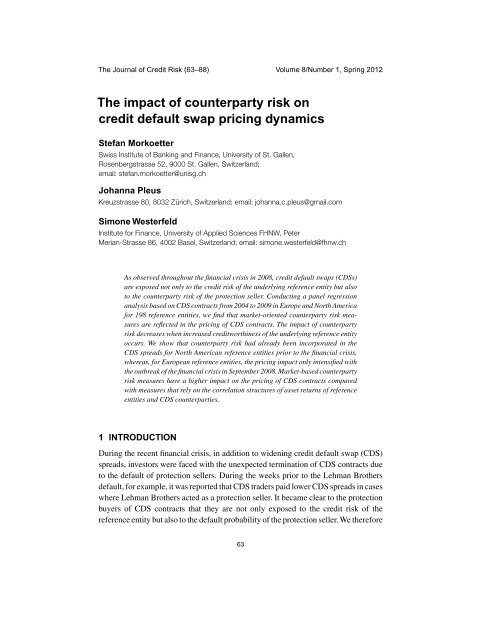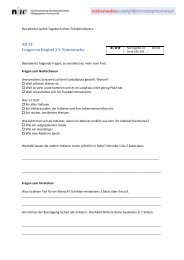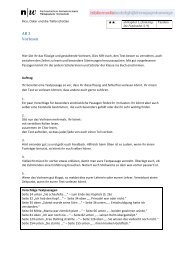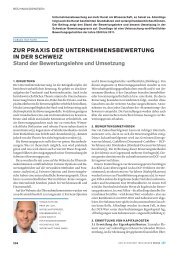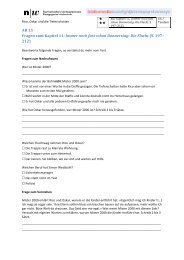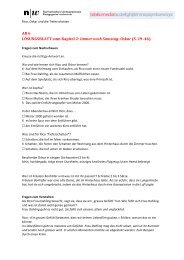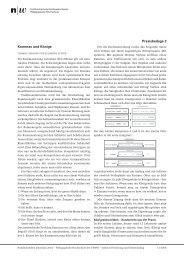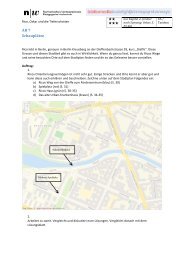The impact of counterparty risk on credit default swap pricing dynamics
The impact of counterparty risk on credit default swap pricing dynamics
The impact of counterparty risk on credit default swap pricing dynamics
Create successful ePaper yourself
Turn your PDF publications into a flip-book with our unique Google optimized e-Paper software.
<str<strong>on</strong>g>The</str<strong>on</strong>g> Journal <str<strong>on</strong>g>of</str<strong>on</strong>g> Credit Risk (63–88) Volume 8/Number 1, Spring 2012<str<strong>on</strong>g>The</str<strong>on</strong>g> <str<strong>on</strong>g>impact</str<strong>on</strong>g> <str<strong>on</strong>g>of</str<strong>on</strong>g> <str<strong>on</strong>g>counterparty</str<strong>on</strong>g> <str<strong>on</strong>g>risk</str<strong>on</strong>g> <strong>on</strong><strong>credit</strong> <strong>default</strong> <strong>swap</strong> <strong>pricing</strong> <strong>dynamics</strong>Stefan MorkoetterSwiss Institute <str<strong>on</strong>g>of</str<strong>on</strong>g> Banking and Finance, University <str<strong>on</strong>g>of</str<strong>on</strong>g> St. Gallen,Rosenbergstrasse 52, 9000 St. Gallen, Switzerland;email: stefan.morkoetter@unisg.chJohanna PleusKreuzstrasse 80, 8032 Zürich, Switzerland; email: johanna.c.pleus@gmail.comSim<strong>on</strong>e WesterfeldInstitute for Finance, University <str<strong>on</strong>g>of</str<strong>on</strong>g> Applied Sciences FHNW, PeterMerian-Strasse 86, 4002 Basel, Switzerland; email: sim<strong>on</strong>e.westerfeld@fhnw.chAs observed throughout the financial crisis in 2008, <strong>credit</strong> <strong>default</strong> <strong>swap</strong>s (CDSs)are exposed not <strong>on</strong>ly to the <strong>credit</strong> <str<strong>on</strong>g>risk</str<strong>on</strong>g> <str<strong>on</strong>g>of</str<strong>on</strong>g> the underlying reference entity but alsoto the <str<strong>on</strong>g>counterparty</str<strong>on</strong>g> <str<strong>on</strong>g>risk</str<strong>on</strong>g> <str<strong>on</strong>g>of</str<strong>on</strong>g> the protecti<strong>on</strong> seller. C<strong>on</strong>ducting a panel regressi<strong>on</strong>analysis based <strong>on</strong> CDS c<strong>on</strong>tracts from 2004 to 2009 in Europe and North Americafor 198 reference entities, we find that market-oriented <str<strong>on</strong>g>counterparty</str<strong>on</strong>g> <str<strong>on</strong>g>risk</str<strong>on</strong>g> measuresare reflected in the <strong>pricing</strong> <str<strong>on</strong>g>of</str<strong>on</strong>g> CDS c<strong>on</strong>tracts. <str<strong>on</strong>g>The</str<strong>on</strong>g> <str<strong>on</strong>g>impact</str<strong>on</strong>g> <str<strong>on</strong>g>of</str<strong>on</strong>g> <str<strong>on</strong>g>counterparty</str<strong>on</strong>g><str<strong>on</strong>g>risk</str<strong>on</strong>g> decreases when increased <strong>credit</strong>worthiness <str<strong>on</strong>g>of</str<strong>on</strong>g> the underlying reference entityoccurs. We show that <str<strong>on</strong>g>counterparty</str<strong>on</strong>g> <str<strong>on</strong>g>risk</str<strong>on</strong>g> had already been incorporated in theCDS spreads for North American reference entities prior to the financial crisis,whereas, for European reference entities, the <strong>pricing</strong> <str<strong>on</strong>g>impact</str<strong>on</strong>g> <strong>on</strong>ly intensified withthe outbreak <str<strong>on</strong>g>of</str<strong>on</strong>g> the financial crisis in September 2008. Market-based <str<strong>on</strong>g>counterparty</str<strong>on</strong>g><str<strong>on</strong>g>risk</str<strong>on</strong>g> measures have a higher <str<strong>on</strong>g>impact</str<strong>on</strong>g> <strong>on</strong> the <strong>pricing</strong> <str<strong>on</strong>g>of</str<strong>on</strong>g> CDS c<strong>on</strong>tracts comparedwith measures that rely <strong>on</strong> the correlati<strong>on</strong> structures <str<strong>on</strong>g>of</str<strong>on</strong>g> asset returns <str<strong>on</strong>g>of</str<strong>on</strong>g> referenceentities and CDS counterparties.1 INTRODUCTIONDuring the recent financial crisis, in additi<strong>on</strong> to widening <strong>credit</strong> <strong>default</strong> <strong>swap</strong> (CDS)spreads, investors were faced with the unexpected terminati<strong>on</strong> <str<strong>on</strong>g>of</str<strong>on</strong>g> CDS c<strong>on</strong>tracts dueto the <strong>default</strong> <str<strong>on</strong>g>of</str<strong>on</strong>g> protecti<strong>on</strong> sellers. During the weeks prior to the Lehman Brothers<strong>default</strong>, for example, it was reported that CDS traders paid lower CDS spreads in caseswhere Lehman Brothers acted as a protecti<strong>on</strong> seller. It became clear to the protecti<strong>on</strong>buyers <str<strong>on</strong>g>of</str<strong>on</strong>g> CDS c<strong>on</strong>tracts that they are not <strong>on</strong>ly exposed to the <strong>credit</strong> <str<strong>on</strong>g>risk</str<strong>on</strong>g> <str<strong>on</strong>g>of</str<strong>on</strong>g> thereference entity but also to the <strong>default</strong> probability <str<strong>on</strong>g>of</str<strong>on</strong>g> the protecti<strong>on</strong> seller. We therefore63
64 S. Morkoetter et aldefine <str<strong>on</strong>g>counterparty</str<strong>on</strong>g> <str<strong>on</strong>g>risk</str<strong>on</strong>g> as the <strong>default</strong> probability <str<strong>on</strong>g>of</str<strong>on</strong>g> the protecti<strong>on</strong> seller. Previously,financial literature <strong>on</strong> the valuati<strong>on</strong> <str<strong>on</strong>g>of</str<strong>on</strong>g> <strong>credit</strong> <strong>default</strong> <strong>swap</strong>s has recommended a <strong>default</strong>correlati<strong>on</strong> framework in the style <str<strong>on</strong>g>of</str<strong>on</strong>g> Mert<strong>on</strong> (1974) to capture <str<strong>on</strong>g>counterparty</str<strong>on</strong>g> <str<strong>on</strong>g>risk</str<strong>on</strong>g>. Thisapproach relies <strong>on</strong> l<strong>on</strong>g-term ex ante asset correlati<strong>on</strong>s in order to assess ex interim<strong>default</strong> correlati<strong>on</strong> between the protecti<strong>on</strong> seller and the underlying reference entity.As observed throughout the financial crisis, this framework was not able to fully reflectthe <str<strong>on</strong>g>counterparty</str<strong>on</strong>g> <str<strong>on</strong>g>risk</str<strong>on</strong>g> exposure <str<strong>on</strong>g>of</str<strong>on</strong>g> CDS c<strong>on</strong>tracts. 1Against this background, our paper aims to introduce and empirically test two differentproxies for <str<strong>on</strong>g>counterparty</str<strong>on</strong>g> <str<strong>on</strong>g>risk</str<strong>on</strong>g>. Our first measure directly reflects changes inmarket percepti<strong>on</strong>s <str<strong>on</strong>g>of</str<strong>on</strong>g> <str<strong>on</strong>g>counterparty</str<strong>on</strong>g> <str<strong>on</strong>g>risk</str<strong>on</strong>g>, and refers to the <strong>credit</strong> <str<strong>on</strong>g>risk</str<strong>on</strong>g> <str<strong>on</strong>g>of</str<strong>on</strong>g> the bankstrading CDS c<strong>on</strong>tracts (average banks’ CDS spreads) adjusted according to the corresp<strong>on</strong>dingCDS index level. We thereby create abnormal <str<strong>on</strong>g>counterparty</str<strong>on</strong>g> spreads inexcess <str<strong>on</strong>g>of</str<strong>on</strong>g> market levels. For our sec<strong>on</strong>d measure we follow the approach <str<strong>on</strong>g>of</str<strong>on</strong>g> modeling<strong>default</strong> correlati<strong>on</strong>s between the reference entity and the protecti<strong>on</strong> seller based <strong>on</strong>asset return correlati<strong>on</strong> structures (see Hull and White (2001)).<str<strong>on</strong>g>The</str<strong>on</strong>g> recent financial crisis has shown that the dominating <strong>pricing</strong> models for CDSc<strong>on</strong>tracts do not fully reflect the <str<strong>on</strong>g>risk</str<strong>on</strong>g> exposure <str<strong>on</strong>g>of</str<strong>on</strong>g> the CDS c<strong>on</strong>tracts. We c<strong>on</strong>tributeto the existing literature by extending the framework for modeling <str<strong>on</strong>g>counterparty</str<strong>on</strong>g> <str<strong>on</strong>g>risk</str<strong>on</strong>g>by proposing a short-term market-oriented perspective. By introducing our marketbasedmeasure we are able to reflect the current market c<strong>on</strong>diti<strong>on</strong>s <str<strong>on</strong>g>of</str<strong>on</strong>g> counterpartiesmore accurately and do not have to rely <strong>on</strong>ly <strong>on</strong> l<strong>on</strong>g-term ex ante data. This allowsus to immediately mirror changing market c<strong>on</strong>diti<strong>on</strong>s such as increasing <strong>credit</strong> <str<strong>on</strong>g>risk</str<strong>on</strong>g>or volatility spikes.In order to test this hypothesis empirically, we c<strong>on</strong>duct a panel regressi<strong>on</strong> analysisbased <strong>on</strong> CDS c<strong>on</strong>tracts from 2004 to 2009 in Europe and North America. We adjustfor entity-fixed and time-fixed effects and develop two <str<strong>on</strong>g>counterparty</str<strong>on</strong>g> <strong>default</strong> measures,which are analyzed both individually and in the c<strong>on</strong>text <str<strong>on</strong>g>of</str<strong>on</strong>g> additi<strong>on</strong>al determinants <str<strong>on</strong>g>of</str<strong>on</strong>g>CDS spreads.Our results have three dimensi<strong>on</strong>s. First, it is shown that <str<strong>on</strong>g>counterparty</str<strong>on</strong>g> <strong>default</strong> <str<strong>on</strong>g>risk</str<strong>on</strong>g>measures, which have been adjusted for the level <str<strong>on</strong>g>of</str<strong>on</strong>g> the respective CDS index, havea negative <str<strong>on</strong>g>impact</str<strong>on</strong>g> <strong>on</strong> CDS spreads in Europe and in North America in the specifiedperiod <str<strong>on</strong>g>of</str<strong>on</strong>g> time.Abnormal <str<strong>on</strong>g>counterparty</str<strong>on</strong>g> CDS spreads lead to lower CDS spreads for theprotecti<strong>on</strong> buyer, whereas the <str<strong>on</strong>g>impact</str<strong>on</strong>g> <str<strong>on</strong>g>of</str<strong>on</strong>g> <str<strong>on</strong>g>counterparty</str<strong>on</strong>g> <str<strong>on</strong>g>risk</str<strong>on</strong>g> decreases as the <strong>credit</strong>worthiness<str<strong>on</strong>g>of</str<strong>on</strong>g> the underlying reference entity increases. Sec<strong>on</strong>d, we find that <str<strong>on</strong>g>counterparty</str<strong>on</strong>g><str<strong>on</strong>g>risk</str<strong>on</strong>g> had already been reflected in the CDS spreads for North American reference entitiesprior to the financial crisis, whereas, for European reference entities, the <strong>pricing</strong><str<strong>on</strong>g>impact</str<strong>on</strong>g> <strong>on</strong>ly intensified with the outbreak <str<strong>on</strong>g>of</str<strong>on</strong>g> the financial crisis in September 2008.1<str<strong>on</strong>g>The</str<strong>on</strong>g>re is, however, a growing literature <strong>on</strong> the sophisticated evaluati<strong>on</strong> <str<strong>on</strong>g>of</str<strong>on</strong>g> CDS c<strong>on</strong>tracts withmodels that can be calibrated to market data (see, for example, Mahfoudhi (2011)).<str<strong>on</strong>g>The</str<strong>on</strong>g> Journal <str<strong>on</strong>g>of</str<strong>on</strong>g> Credit Risk Volume 8/Number 1, Spring 2012
<str<strong>on</strong>g>The</str<strong>on</strong>g> <str<strong>on</strong>g>impact</str<strong>on</strong>g> <str<strong>on</strong>g>of</str<strong>on</strong>g> <str<strong>on</strong>g>counterparty</str<strong>on</strong>g> <str<strong>on</strong>g>risk</str<strong>on</strong>g> <strong>on</strong> CDS <strong>pricing</strong> <strong>dynamics</strong> 65Third, market-based <str<strong>on</strong>g>counterparty</str<strong>on</strong>g> <str<strong>on</strong>g>risk</str<strong>on</strong>g> measures have a higher <str<strong>on</strong>g>impact</str<strong>on</strong>g> <strong>on</strong> the <strong>pricing</strong> <str<strong>on</strong>g>of</str<strong>on</strong>g>CDS c<strong>on</strong>tracts than do measures that rely <strong>on</strong> the correlati<strong>on</strong> structures <str<strong>on</strong>g>of</str<strong>on</strong>g> asset returns<str<strong>on</strong>g>of</str<strong>on</strong>g> reference entities and CDS counterparties. Our results are <str<strong>on</strong>g>of</str<strong>on</strong>g> particular interest forinvestors, but also for regulators demanding a higher degree <str<strong>on</strong>g>of</str<strong>on</strong>g> transparency in <strong>credit</strong>derivative markets.<str<strong>on</strong>g>The</str<strong>on</strong>g> remainder <str<strong>on</strong>g>of</str<strong>on</strong>g> the paper is organized as follows. Based <strong>on</strong> a literature reviewin Secti<strong>on</strong> 2, in Secti<strong>on</strong> 3 we introduce the data used, and in Secti<strong>on</strong> 4 we presentthe applied methodology <str<strong>on</strong>g>of</str<strong>on</strong>g> <str<strong>on</strong>g>counterparty</str<strong>on</strong>g> <str<strong>on</strong>g>risk</str<strong>on</strong>g>. Secti<strong>on</strong> 5 gives a presentati<strong>on</strong> <str<strong>on</strong>g>of</str<strong>on</strong>g> theempirical results, and these are then discussed in Secti<strong>on</strong> 6. Secti<strong>on</strong> 7 c<strong>on</strong>cludes thepaper.2 LITERATURE REVIEWA large body <str<strong>on</strong>g>of</str<strong>on</strong>g> financial literature has emerged <strong>on</strong> the subject <str<strong>on</strong>g>of</str<strong>on</strong>g> the <strong>pricing</strong> structure<str<strong>on</strong>g>of</str<strong>on</strong>g> CDS spreads.Against the background <str<strong>on</strong>g>of</str<strong>on</strong>g> our main research questi<strong>on</strong>, two strands <str<strong>on</strong>g>of</str<strong>on</strong>g>literature can be distinguished: first, literature relating to modeling the <str<strong>on</strong>g>counterparty</str<strong>on</strong>g><str<strong>on</strong>g>risk</str<strong>on</strong>g> <str<strong>on</strong>g>of</str<strong>on</strong>g> CDS c<strong>on</strong>tracts; and sec<strong>on</strong>d, research focusing <strong>on</strong> additi<strong>on</strong>al <strong>pricing</strong> determinants<str<strong>on</strong>g>of</str<strong>on</strong>g> CDS c<strong>on</strong>tracts, which will be used later in the paper as c<strong>on</strong>trol variables forour model.Duffie (1999) develops a <strong>pricing</strong> model for <strong>credit</strong> <strong>default</strong> <strong>swap</strong>s, modeling the hazardrate as a Poiss<strong>on</strong> process arrival rate <str<strong>on</strong>g>of</str<strong>on</strong>g> <strong>default</strong>, where the reference entity’s <strong>default</strong>process is determined by the first jump time <str<strong>on</strong>g>of</str<strong>on</strong>g> the specified Poiss<strong>on</strong> process. Extendingthe reduced-form model by Duffie (1999) with regard to <str<strong>on</strong>g>counterparty</str<strong>on</strong>g> <strong>default</strong> <str<strong>on</strong>g>risk</str<strong>on</strong>g>,Jarrow and Yu (2001) apply the primary–sec<strong>on</strong>dary framework. Hence, the <strong>default</strong>process <str<strong>on</strong>g>of</str<strong>on</strong>g> a primary firm is exclusively dependent <strong>on</strong> macrovariables. Sec<strong>on</strong>daryfirms’ <strong>default</strong> processes, however, are not <strong>on</strong>ly dependent <strong>on</strong> macrovariables but also<strong>on</strong> the primary firms’ <strong>default</strong> processes. Leung and Kwok (2005) further incorporateinterdependent <strong>default</strong> correlati<strong>on</strong>s between the protecti<strong>on</strong> buyer, the protecti<strong>on</strong>seller and the reference entity. Relating to this literature, recent work by Gündüz andUhrig-Homburg (2011) provides an empirical comparis<strong>on</strong> <str<strong>on</strong>g>of</str<strong>on</strong>g> structural and reducedform<strong>credit</strong> <str<strong>on</strong>g>risk</str<strong>on</strong>g> frameworks by assessing the out-<str<strong>on</strong>g>of</str<strong>on</strong>g>-sample predicti<strong>on</strong> quality <strong>on</strong> timeseries <str<strong>on</strong>g>of</str<strong>on</strong>g> CDS prices. <str<strong>on</strong>g>The</str<strong>on</strong>g> authors find that the model’s predicti<strong>on</strong> power is quite closeto average, with an outperformance <str<strong>on</strong>g>of</str<strong>on</strong>g> reduced-form approaches for investment gradenames and l<strong>on</strong>ger maturities.Hull and White (2000, 2001) develop a direct <strong>pricing</strong> model for <strong>credit</strong> <strong>default</strong> <strong>swap</strong>swith <str<strong>on</strong>g>counterparty</str<strong>on</strong>g> <strong>default</strong> <str<strong>on</strong>g>risk</str<strong>on</strong>g>. Whereas Duffie (1999) models the hazard rate as theprobability that the b<strong>on</strong>d will <strong>default</strong> within a time frame between t and t Ct,givenno earlier <strong>default</strong>, Hull andWhite (2000) define the probability density functi<strong>on</strong> as seenat the issuance <str<strong>on</strong>g>of</str<strong>on</strong>g> the CDS c<strong>on</strong>tract at time zero. By incorporating <strong>default</strong> correlati<strong>on</strong>sbetween different entities, Hull and White (2001) extend their valuati<strong>on</strong> model byResearch Paperwww.journal<str<strong>on</strong>g>of</str<strong>on</strong>g><strong>credit</strong><str<strong>on</strong>g>risk</str<strong>on</strong>g>.com
66 S. Morkoetter et altaking into account <str<strong>on</strong>g>counterparty</str<strong>on</strong>g> <strong>default</strong> <str<strong>on</strong>g>risk</str<strong>on</strong>g> and compute the <strong>default</strong> correlati<strong>on</strong>between two firms from their respective <strong>credit</strong> index correlati<strong>on</strong>. <str<strong>on</strong>g>The</str<strong>on</strong>g> higher the <strong>default</strong>correlati<strong>on</strong> between the buyer and the seller <str<strong>on</strong>g>of</str<strong>on</strong>g> the CDS and the lower the <strong>credit</strong> quality<str<strong>on</strong>g>of</str<strong>on</strong>g> the issuer, the higher the <str<strong>on</strong>g>impact</str<strong>on</strong>g> <str<strong>on</strong>g>of</str<strong>on</strong>g> the <strong>default</strong> correlati<strong>on</strong> <strong>on</strong> <str<strong>on</strong>g>counterparty</str<strong>on</strong>g> <strong>default</strong><str<strong>on</strong>g>risk</str<strong>on</strong>g>. Mahfoudhi (2011) proposes a CDS tree model that simplifies and unifies the CDSvaluati<strong>on</strong> based <strong>on</strong> the incorporating <str<strong>on</strong>g>of</str<strong>on</strong>g> extended market data, which might also helpto incorporate <str<strong>on</strong>g>counterparty</str<strong>on</strong>g> <strong>default</strong> comp<strong>on</strong>ents assuming that these are c<strong>on</strong>tained inmarket prices.<str<strong>on</strong>g>The</str<strong>on</strong>g> sec<strong>on</strong>d branch <str<strong>on</strong>g>of</str<strong>on</strong>g> literature deals with <strong>pricing</strong> determinants <str<strong>on</strong>g>of</str<strong>on</strong>g> CDS spreads.A wide range <str<strong>on</strong>g>of</str<strong>on</strong>g> microec<strong>on</strong>omic and macroec<strong>on</strong>omic factors have been analyzed inthis c<strong>on</strong>text. Early empirical research shows that, besides the rating <str<strong>on</strong>g>of</str<strong>on</strong>g> the underlyingbeing the most powerful source <str<strong>on</strong>g>of</str<strong>on</strong>g> informati<strong>on</strong>, other factors, such as <str<strong>on</strong>g>risk</str<strong>on</strong>g>-free interestrate, stock return <str<strong>on</strong>g>of</str<strong>on</strong>g> the reference entity, interest rate volatility, maturity and exerciseprice, should be incorporated into models (see Skinner and Townend (2002)).L<strong>on</strong>gstaff et al (2005) find that implied CDS spreads significantly exceed marketspreads due to treasury specificati<strong>on</strong>s, illiquidity in corporate b<strong>on</strong>d markets and thepresence <str<strong>on</strong>g>of</str<strong>on</strong>g> <str<strong>on</strong>g>counterparty</str<strong>on</strong>g> <strong>credit</strong> <str<strong>on</strong>g>risk</str<strong>on</strong>g>. Das et al (2009) compare the explanatory power<str<strong>on</strong>g>of</str<strong>on</strong>g> accounting-based and market-based models <str<strong>on</strong>g>of</str<strong>on</strong>g> CDS spreads and find that modelsincluding both accounting and market informati<strong>on</strong> perform better than separate models.Alexander and Kaeck (2008) dem<strong>on</strong>strate that, in times <str<strong>on</strong>g>of</str<strong>on</strong>g> ec<strong>on</strong>omic turbulence,CDS spreads react more sensitively toward equity volatility, whereas CDS spreadsare usually more sensitive with regard to equity returns.Ericss<strong>on</strong> et al (2009) c<strong>on</strong>clude that theoretically implied variables, such as leverageand volatility, explain a significant proporti<strong>on</strong> <str<strong>on</strong>g>of</str<strong>on</strong>g> CDS variati<strong>on</strong>s. In c<strong>on</strong>trast to themajority <str<strong>on</strong>g>of</str<strong>on</strong>g> empirical analyses <strong>on</strong> the determinants <str<strong>on</strong>g>of</str<strong>on</strong>g> CDS spreads, Pires et al (2008)apply a quantile regressi<strong>on</strong> approach in order to model the distributi<strong>on</strong> <str<strong>on</strong>g>of</str<strong>on</strong>g> CDS spreads.<str<strong>on</strong>g>The</str<strong>on</strong>g> authors reveal that results differ significantly between lower- and higher-ratedfirms and claim that, besides traditi<strong>on</strong>al variables, a transacti<strong>on</strong> costs perspectiveshould be included in the regressi<strong>on</strong> model.Additi<strong>on</strong>ally, Fabozzi et al (2007) analyze the variables <str<strong>on</strong>g>of</str<strong>on</strong>g> <str<strong>on</strong>g>risk</str<strong>on</strong>g>-free term structure,industry, <strong>credit</strong> rating and liquidity and find a positive relati<strong>on</strong>ship between the liquidityfactors and CDS premiums. By establishing liquidity proxies capturing adverseselecti<strong>on</strong>, inventory costs and search fricti<strong>on</strong>s, Tang andYan (2007) provide evidencethat liquidity <str<strong>on</strong>g>risk</str<strong>on</strong>g> and liquidity level explain a significant proporti<strong>on</strong> <str<strong>on</strong>g>of</str<strong>on</strong>g> CDS spreadvariati<strong>on</strong>.Byström (2005) and Zhang et al (2008) specifically investigate the <str<strong>on</strong>g>impact</str<strong>on</strong>g> <str<strong>on</strong>g>of</str<strong>on</strong>g> equityreturns and volatility <str<strong>on</strong>g>of</str<strong>on</strong>g> the reference entity <strong>on</strong> the CDS premium. Exploring the relati<strong>on</strong>shipbetween the CDS index market and the stock market, Byström (2005) showsthat CDS spreads tighten in resp<strong>on</strong>se to increasing stock prices and that stock pricevolatility is positively correlated with CDS prices. Having c<strong>on</strong>trolled for historical<str<strong>on</strong>g>The</str<strong>on</strong>g> Journal <str<strong>on</strong>g>of</str<strong>on</strong>g> Credit Risk Volume 8/Number 1, Spring 2012
<str<strong>on</strong>g>The</str<strong>on</strong>g> <str<strong>on</strong>g>impact</str<strong>on</strong>g> <str<strong>on</strong>g>of</str<strong>on</strong>g> <str<strong>on</strong>g>counterparty</str<strong>on</strong>g> <str<strong>on</strong>g>risk</str<strong>on</strong>g> <strong>on</strong> CDS <strong>pricing</strong> <strong>dynamics</strong> 67<strong>default</strong> probabilities and by calibrating a structural valuati<strong>on</strong> model with stochasticequity volatility and jump <str<strong>on</strong>g>risk</str<strong>on</strong>g>s, Zhang et al (2008) explain 73% <str<strong>on</strong>g>of</str<strong>on</strong>g> the variati<strong>on</strong> <str<strong>on</strong>g>of</str<strong>on</strong>g>CDS spreads.Houweling andVorst (2001) c<strong>on</strong>duct an empirical analysis comparing CDS spreadsimplied by a simple reduced-form framework with market CDS spreads derived fromthe underlying b<strong>on</strong>d’s <strong>credit</strong> spread. Using <strong>swap</strong> or repurchasing agreements (repo)curves instead <str<strong>on</strong>g>of</str<strong>on</strong>g> the treasury rate as a proxy for the <str<strong>on</strong>g>risk</str<strong>on</strong>g>less interest rate, they maintainan outperformance <str<strong>on</strong>g>of</str<strong>on</strong>g> model-implied CDS spreads compared with market practice.3 DATA SAMPLE<str<strong>on</strong>g>The</str<strong>on</strong>g> ensuing analysis <strong>on</strong> the <str<strong>on</strong>g>impact</str<strong>on</strong>g> <str<strong>on</strong>g>of</str<strong>on</strong>g> <str<strong>on</strong>g>counterparty</str<strong>on</strong>g> <str<strong>on</strong>g>risk</str<strong>on</strong>g> <strong>on</strong> CDS spread levels isbased <strong>on</strong> a data sample <str<strong>on</strong>g>of</str<strong>on</strong>g> 198 different reference entities. Our data set includes bothEuropean and North American reference entities, and all are derived from the majorCDS indexes. <str<strong>on</strong>g>The</str<strong>on</strong>g> CDS c<strong>on</strong>tracts analyzed are taken from the Markit iTraxx IndexSeries 1 for the European market and from the Markit CDX Investment Grade IndexSeries 3 for the North American market. Our analysis focuses <strong>on</strong> the most liquid andmost frequently traded c<strong>on</strong>tracts in terms <str<strong>on</strong>g>of</str<strong>on</strong>g> transacti<strong>on</strong> volume. Thus, we are able toexclude any potential bias relating to company size or trading volume, since all CDSc<strong>on</strong>tracts are written <strong>on</strong> large blue chip companies. <str<strong>on</strong>g>The</str<strong>on</strong>g> time period <str<strong>on</strong>g>of</str<strong>on</strong>g> this analysisis restricted to the trading period <str<strong>on</strong>g>of</str<strong>on</strong>g> the selected indexes and ranges from September2004 to December 2009. In terms <str<strong>on</strong>g>of</str<strong>on</strong>g> maturity structure and underlying securities wefollow existing finance literature and use CDS c<strong>on</strong>tracts <strong>on</strong> corporate senior debt witha fixed maturity <str<strong>on</strong>g>of</str<strong>on</strong>g> five years.Following Zhang et al (2008), where m<strong>on</strong>thly data is favored in order to minimizethe effect <str<strong>on</strong>g>of</str<strong>on</strong>g> autocorrelati<strong>on</strong> resulting in a mitigati<strong>on</strong> <str<strong>on</strong>g>of</str<strong>on</strong>g> an estimati<strong>on</strong> bias, we applym<strong>on</strong>thly data for our panel analysis.As Zhang et al (2008) suggest, high CDS spreads,which indicate the existence <str<strong>on</strong>g>of</str<strong>on</strong>g> bilateral agreements <strong>on</strong> upfr<strong>on</strong>t payments observati<strong>on</strong>swith spreads above 15%, are removed from the data. 2 We excluded all referenceentities that were either not publicly listed (so that no informati<strong>on</strong> regarding theequity returns and volatility could be retrieved) or had CDS spreads quoted for lessthan twenty-four m<strong>on</strong>ths.All data is retrieved from Bloomberg. 3 Our reference entities2For Europe, two outliers with CDS spreads exceeding the 15% threshold are deleted, and, forNorth America, fourteen observati<strong>on</strong>s are deleted.3Markit iTraxx Europe Index Series 1 comprises 125 CDS c<strong>on</strong>tracts <strong>on</strong> senior unsecured debtwith maturity <str<strong>on</strong>g>of</str<strong>on</strong>g> five years <strong>on</strong> investment grade entities distinguished by the subindexes autos,c<strong>on</strong>sumer goods, energy, industrial goods, TMT (which stands for telecommunicati<strong>on</strong>s, media andtechnology), financials, n<strong>on</strong>financials and high volatility. Markit CDX Dow J<strong>on</strong>es CDX InvestmentGrade Index North America comprises 125 CDS c<strong>on</strong>tracts <str<strong>on</strong>g>of</str<strong>on</strong>g> senior unsecured debt with maturity <str<strong>on</strong>g>of</str<strong>on</strong>g>five years <strong>on</strong> investment grade firms. Subindexes are clustered by high volatility, c<strong>on</strong>sumer goods,energy, financial, industrial goods and TMT. Both Markit indexes roll every six m<strong>on</strong>ths.Research Paperwww.journal<str<strong>on</strong>g>of</str<strong>on</strong>g><strong>credit</strong><str<strong>on</strong>g>risk</str<strong>on</strong>g>.com
68 S. Morkoetter et alTABLE 1Overview <str<strong>on</strong>g>of</str<strong>on</strong>g> yearly mean CDS spreads across rating categories.AAA–A BBB BB–C Total‚ …„ ƒ ‚ …„ ƒ ‚ …„ ƒ ‚ …„ ƒYear CDX iTraxx CDX iTraxx CDX iTraxx CDX iTraxx2004 29.88 25.68 47.09 53.12 57.74 42.99 41.03 39.572005 27.41 26.05 45.47 53.19 86.43 79.39 42.93 44.692006 20.61 17.32 34.47 41.33 96.96 66.47 36.36 34.272007 21.82 20.77 35.36 42.20 138.16 76.91 42.46 37.992008 93.84 94.98 143.78 159.50 483.56 328.88 163.53 154.682009 157.68 108.05 241.73 166.48 635.96 454.78 252.68 181.91Total 46.82 48.56 75.73 85.68 211.97 178.59 80.28 82.06Time-weighted average CDS spreads <str<strong>on</strong>g>of</str<strong>on</strong>g> the respective index c<strong>on</strong>stituents per year for the three rating clustersranging from AAA–A, BBB and BB–C ratings. Overall, CDS spreads in lower rating classes exceed the AAA ratingclasses and CDS spreads increase significantly in 2008 and 2009 in the CDX and iTraxx index.originate from different industries as well as incorporating different rating classes,which further reduces the probability that our results are affected by a selecti<strong>on</strong> bias.Rating values are assigned according to a Standard & Poor’s rating or, if this is notavailable, the Moody’s <strong>credit</strong> rating is used. In total, the iTraxx data sample c<strong>on</strong>sists<str<strong>on</strong>g>of</str<strong>on</strong>g> 5379 observati<strong>on</strong>s and the CDX data sample c<strong>on</strong>sists <str<strong>on</strong>g>of</str<strong>on</strong>g> 5053 observati<strong>on</strong>s. Forthe subsequent regressi<strong>on</strong> analysis we further excluded observati<strong>on</strong>s with differencedCDS spreads exceeding the 10% limit in order to ensure that individual events such aslow liquidity levels do not affect our empirical results. Despite this, the total number<str<strong>on</strong>g>of</str<strong>on</strong>g> excluded CDS spreads is <strong>on</strong> a very modest level.Table 1 presents an overview <str<strong>on</strong>g>of</str<strong>on</strong>g> the yearly mean CDS spreads across the differentrating categories. <str<strong>on</strong>g>The</str<strong>on</strong>g> aforementi<strong>on</strong>ed negative relati<strong>on</strong>ship between quality <str<strong>on</strong>g>of</str<strong>on</strong>g> ratingclass (eg, low <strong>default</strong> probability) and level <str<strong>on</strong>g>of</str<strong>on</strong>g> CDS spreads is also c<strong>on</strong>firmed for ourdata sample. Additi<strong>on</strong>ally, we detect an already well-documented trend <str<strong>on</strong>g>of</str<strong>on</strong>g> decreasingmean CDS spreads until 2006–7 and a sudden increase with the beginning <str<strong>on</strong>g>of</str<strong>on</strong>g> thefinancial crisis in 2008.Table 2 <strong>on</strong> page 70 displays summary statistics <str<strong>on</strong>g>of</str<strong>on</strong>g> the CDS <strong>pricing</strong> determinants.We divided the results into two parts (Europe and North America) and listed boththe <str<strong>on</strong>g>counterparty</str<strong>on</strong>g> <str<strong>on</strong>g>risk</str<strong>on</strong>g> measure and the c<strong>on</strong>trol variables accordingly. In this c<strong>on</strong>text itbecomes obvious that the characteristics for the CDS markets in North America andin Europe are quite different (eg, higher liquidity and leverage for the US sample).Thus, we will separate our regressi<strong>on</strong> analysis into a US and a European sample. Wealso observe that the financial crisis has a significant <str<strong>on</strong>g>impact</str<strong>on</strong>g> <strong>on</strong> the different <strong>pricing</strong>comp<strong>on</strong>ents <str<strong>on</strong>g>of</str<strong>on</strong>g> CDS spreads with the <strong>pricing</strong> c<strong>on</strong>diti<strong>on</strong>s tightening after September2008.<str<strong>on</strong>g>The</str<strong>on</strong>g> Journal <str<strong>on</strong>g>of</str<strong>on</strong>g> Credit Risk Volume 8/Number 1, Spring 2012
<str<strong>on</strong>g>The</str<strong>on</strong>g> <str<strong>on</strong>g>impact</str<strong>on</strong>g> <str<strong>on</strong>g>of</str<strong>on</strong>g> <str<strong>on</strong>g>counterparty</str<strong>on</strong>g> <str<strong>on</strong>g>risk</str<strong>on</strong>g> <strong>on</strong> CDS <strong>pricing</strong> <strong>dynamics</strong> 694 METHODOLOGY4.1 Counterparty <str<strong>on</strong>g>risk</str<strong>on</strong>g> and <strong>credit</strong> <strong>default</strong> <strong>swap</strong>sIn what follows, we introduce two different measures for including <str<strong>on</strong>g>counterparty</str<strong>on</strong>g> <str<strong>on</strong>g>risk</str<strong>on</strong>g>in a CDS <strong>pricing</strong> model. <str<strong>on</strong>g>The</str<strong>on</strong>g> first variable (CPDR1) does not rely <strong>on</strong>ly <strong>on</strong> <strong>default</strong>correlati<strong>on</strong> patterns derived from Mert<strong>on</strong> (1974) style ex ante asset/debt returns butmimics ex interim market c<strong>on</strong>diti<strong>on</strong>s. <str<strong>on</strong>g>The</str<strong>on</strong>g> sec<strong>on</strong>d variable <str<strong>on</strong>g>of</str<strong>on</strong>g>fers a soluti<strong>on</strong> incorporatingasset correlati<strong>on</strong> structures as introduced by Hull and White (2000, 2001).In a sec<strong>on</strong>d step we introduce a series <str<strong>on</strong>g>of</str<strong>on</strong>g> additi<strong>on</strong>al c<strong>on</strong>trol variables that are allderived from the existing literature and have exhibited significant <strong>pricing</strong> power fordetermining CDS spreads. As discussed above, <strong>default</strong> <str<strong>on</strong>g>risk</str<strong>on</strong>g> has a negative <str<strong>on</strong>g>impact</str<strong>on</strong>g> <strong>on</strong>CDS premiums (see Hull and White (2001)). Furthermore, the interdependent <str<strong>on</strong>g>risk</str<strong>on</strong>g> <str<strong>on</strong>g>of</str<strong>on</strong>g><strong>default</strong> between the underlying reference entity and the issuing <str<strong>on</strong>g>counterparty</str<strong>on</strong>g> are to bec<strong>on</strong>sidered. As <str<strong>on</strong>g>counterparty</str<strong>on</strong>g> specific quotes for single CDS quotes are not availablein the comm<strong>on</strong> CDS databases (eg, Markit) provided by Bloomberg, Datastream orReuters, two proxies for aggregate <str<strong>on</strong>g>counterparty</str<strong>on</strong>g> <strong>default</strong> <str<strong>on</strong>g>risk</str<strong>on</strong>g> are computed. 4With the first proxy we try to overcome this lack <str<strong>on</strong>g>of</str<strong>on</strong>g> data transparency by designingan average measure for <str<strong>on</strong>g>counterparty</str<strong>on</strong>g> <str<strong>on</strong>g>risk</str<strong>on</strong>g> by adjusting for market sentiment. <str<strong>on</strong>g>The</str<strong>on</strong>g>Markit platform provides an overview <str<strong>on</strong>g>of</str<strong>on</strong>g> the banks c<strong>on</strong>tributing to the iTraxx andCDX index. 5 Thus, we compute the first proxy <str<strong>on</strong>g>of</str<strong>on</strong>g> <str<strong>on</strong>g>counterparty</str<strong>on</strong>g> <strong>default</strong> <str<strong>on</strong>g>risk</str<strong>on</strong>g> by takingthe arithmetic mean <str<strong>on</strong>g>of</str<strong>on</strong>g> CDS spreads <str<strong>on</strong>g>of</str<strong>on</strong>g> all banks c<strong>on</strong>tributing to the specific indeximplying the overall <strong>credit</strong>worthiness <str<strong>on</strong>g>of</str<strong>on</strong>g> the c<strong>on</strong>tributing counterparties <strong>on</strong> an actualto-actualbasis. In a sec<strong>on</strong>d step, we extract the general market sentiment in orderto create our first measure for <str<strong>on</strong>g>counterparty</str<strong>on</strong>g> <str<strong>on</strong>g>risk</str<strong>on</strong>g> (CPDR1). At each trading point wesubtract the corresp<strong>on</strong>ding quote <str<strong>on</strong>g>of</str<strong>on</strong>g> the iTraxx index or the CDX index from thearithmetic mean <str<strong>on</strong>g>of</str<strong>on</strong>g> CDS spreads <str<strong>on</strong>g>of</str<strong>on</strong>g> all counterparties. Counterparties are defined asbanks c<strong>on</strong>tributing to the respective iTraxx or CDX index as quoted by Bloomberg.In this way we are able to isolate changes <str<strong>on</strong>g>of</str<strong>on</strong>g> the relevant CDS counterparties fromthe index level resulting in abnormal <str<strong>on</strong>g>counterparty</str<strong>on</strong>g> <str<strong>on</strong>g>risk</str<strong>on</strong>g> spreads:CPDR1 t D CDS 1t C CDS 2t CCCDS NtNindex t (4.1)4<str<strong>on</strong>g>The</str<strong>on</strong>g> reas<strong>on</strong>s why banks c<strong>on</strong>tributing trading data to Markit do not want the individual quotesto be published are easy to comprehend: they would be exposed to market suspici<strong>on</strong> in times<str<strong>on</strong>g>of</str<strong>on</strong>g> financial turbulence, as experienced by Lehman Brothers in August/September 2008, when,within the interbanking market, the Lehman Brothers <str<strong>on</strong>g>counterparty</str<strong>on</strong>g> <str<strong>on</strong>g>risk</str<strong>on</strong>g> did indeed lead to higherCDS spreads compared with other CDS c<strong>on</strong>tracts for the very same reference entity and maturitystructure.5<str<strong>on</strong>g>The</str<strong>on</strong>g> CDS index is a list <str<strong>on</strong>g>of</str<strong>on</strong>g> twenty-five banks in total providing their CDS spreads for the indexc<strong>on</strong>stituents to Markit Financial Informati<strong>on</strong> Services.Research Paperwww.journal<str<strong>on</strong>g>of</str<strong>on</strong>g><strong>credit</strong><str<strong>on</strong>g>risk</str<strong>on</strong>g>.com
70 S. Morkoetter et alTABLE 2 Summary statistics <str<strong>on</strong>g>of</str<strong>on</strong>g> CDS <strong>pricing</strong> determinants. [Table c<strong>on</strong>tinues <strong>on</strong> next page.](a) EuropeSample beforeSample‚Total sample…„ ƒSeptember 2008‚ …„ ƒ ‚after 2008…„ ƒStandard Standard StandardMean deviati<strong>on</strong> Mean deviati<strong>on</strong> Mean deviati<strong>on</strong>CDS spread 81.4385 111.3020 49.2941 49.1746 168.2149 170.2088CPDR1 9.9087 42.7219 0.4392 19.5362 38.2361 68.2777CPDR2 0.3528 0.8734 0.3291 0.8513 0.4284 0.9674Liquidity 0.1189 0.0792 0.1334 0.0870 0.0812 0.0347Return firm 0.0013 0.0887 0.0044 0.0647 0.0077 0.1327Equity 0.0096 0.1301 0.0121 0.1486 0.0104 0.1711volatilityReturn market 0.0020 0.0500 0.0053 0.0382 0.0080 0.0713Market 0.0960 0.6106 0.1163 0.6951 0.1040 0.4088volatilityLeverage 0.4315 0.3321 0.4151 0.3272 0.4784 0.3425Index 66.7479 79.0198 31.0526 16.7400 165.2437 95.6990Interest 10 4.0085 0.6322 4.1332 0.6077 3.7176 0.6090Interest 2 4.6285 12.2151 5.1163 12.1871 3.1774 11.8048Slope 0.6200 12.1870 0.9831 12.1761 0.5402 11.7732Swap rate 3.6998 1.7998 3.8434 1.2433 3.3410 2.7664Swap spread 0.3087 1.7021 0.2897 1.1496 0.3766 2.6824Thus, CPDR1 t reflects the pooled <strong>default</strong> <str<strong>on</strong>g>risk</str<strong>on</strong>g> <str<strong>on</strong>g>of</str<strong>on</strong>g> the c<strong>on</strong>tributing banks, minus theoverall <strong>credit</strong> <str<strong>on</strong>g>risk</str<strong>on</strong>g> in the market. 6 By doing so, our <strong>pricing</strong> model reflects currentmarket c<strong>on</strong>diti<strong>on</strong>s <str<strong>on</strong>g>of</str<strong>on</strong>g> counterparties and does not rely <strong>on</strong> ex ante data <strong>on</strong>ly. This allowsus to immediately mirror changing market c<strong>on</strong>diti<strong>on</strong>s such as increasing <strong>credit</strong> <str<strong>on</strong>g>risk</str<strong>on</strong>g>or volatility spikes. As observed throughout the financial crisis, the approach <str<strong>on</strong>g>of</str<strong>on</strong>g> Hulland White (2001) had the drawback that it was not able to immediately adjust forthe increase in <strong>credit</strong> <str<strong>on</strong>g>risk</str<strong>on</strong>g> <str<strong>on</strong>g>of</str<strong>on</strong>g> the major counterparties. Additi<strong>on</strong>ally, we also derivedour measure from observed market prices for <strong>credit</strong> <str<strong>on</strong>g>risk</str<strong>on</strong>g> and do not solely rely <strong>on</strong> anindirect link via asset returns.6<str<strong>on</strong>g>The</str<strong>on</strong>g> importance <str<strong>on</strong>g>of</str<strong>on</strong>g> <str<strong>on</strong>g>counterparty</str<strong>on</strong>g> <str<strong>on</strong>g>risk</str<strong>on</strong>g> is even accentuated by the fact that modern banks use CDSbased<strong>credit</strong> value adjustments as a measurement <str<strong>on</strong>g>of</str<strong>on</strong>g> <str<strong>on</strong>g>counterparty</str<strong>on</strong>g> <strong>credit</strong> <str<strong>on</strong>g>risk</str<strong>on</strong>g> <strong>on</strong> over-the-counterderivative transacti<strong>on</strong>s and to adjust their liabilities based <strong>on</strong> their own <strong>credit</strong> quality. <str<strong>on</strong>g>The</str<strong>on</strong>g>y do thisby adjusting the discount rate curve by the <str<strong>on</strong>g>counterparty</str<strong>on</strong>g> CDS spread curve. This approach is <strong>on</strong>lyreas<strong>on</strong>able for good counterparties, but it necessitates the analysis presented in this paper.<str<strong>on</strong>g>The</str<strong>on</strong>g> Journal <str<strong>on</strong>g>of</str<strong>on</strong>g> Credit Risk Volume 8/Number 1, Spring 2012
<str<strong>on</strong>g>The</str<strong>on</strong>g> <str<strong>on</strong>g>impact</str<strong>on</strong>g> <str<strong>on</strong>g>of</str<strong>on</strong>g> <str<strong>on</strong>g>counterparty</str<strong>on</strong>g> <str<strong>on</strong>g>risk</str<strong>on</strong>g> <strong>on</strong> CDS <strong>pricing</strong> <strong>dynamics</strong> 71TABLE 2C<strong>on</strong>tinued.(b) North AmericaSample beforeSample‚Total sample…„ ƒSeptember 2008‚ …„ ƒ ‚after 2008…„ ƒStandard Standard StandardMean deviati<strong>on</strong> Mean deviati<strong>on</strong> Mean deviati<strong>on</strong>CDS spread 79.6419 134.6668 53.1857 73.2905 240.2657 256.2292CPDR1 14.7062 28.5680 16.5283 16.9726 3.6435 62.3251CPDR2 0.2988 0.8556 0.3275 0.8802 0.1248 0.6615Liquidity 0.1406 0.0857 0.1515 0.0874 0.0739 0.0208Return firm 0.0070 0.1133 0.0028 0.0718 0.0665 0.2354Equity 0.0080 0.3600 0.0092 0.3885 0.0004 0.0008volatilityReturn market 0.0039 0.0466 0.0034 0.0279 0.0482 0.0917Market 0.0066 0.0209 0.0073 0.0225 0.0028 0.0031volatilityLeverage 0.5179 0.1934 0.5019 0.1882 0.6151 0.1964Index 77.9836 80.0116 0.8802 30.1370 249.0356 75.3505Interest 10 4.1990 0.6351 4.3854 0.4193 3.0673 0.5416Interest 2 3.4804 1.3294 3.8709 0.9767 1.1092 0.3957Slope 0.7186 0.7649 0.5144 0.6124 1.9582 0.2647Swap rate 1.3283 0.1037 1.3299 0.1098 0.2647 0.0520Swap spread 2.8709 0.6713 3.0556 0.4836 0.0520 0.5496Mean and standard deviati<strong>on</strong> for the dependent and independent variables in the total European sample (n D 5379)and the total North American sample (n D 5053), and for samples before September 2008 and samples after 2008.<str<strong>on</strong>g>The</str<strong>on</strong>g>re is, however, a <str<strong>on</strong>g>risk</str<strong>on</strong>g>-mitigati<strong>on</strong> technique in place that might reduce <str<strong>on</strong>g>counterparty</str<strong>on</strong>g><str<strong>on</strong>g>risk</str<strong>on</strong>g>, ie, margin calls that become effective with a deteriorati<strong>on</strong> <str<strong>on</strong>g>of</str<strong>on</strong>g> <strong>credit</strong> quality<str<strong>on</strong>g>of</str<strong>on</strong>g> the <str<strong>on</strong>g>counterparty</str<strong>on</strong>g> if the c<strong>on</strong>tract is closed under standard <strong>swap</strong> agreements based<strong>on</strong> Internati<strong>on</strong>al Swaps and Derivatives Associati<strong>on</strong> rules. We argue, however, thatmargining always carries severe <str<strong>on</strong>g>risk</str<strong>on</strong>g>s, as it is usually triggered by a <str<strong>on</strong>g>counterparty</str<strong>on</strong>g> ratingmigrati<strong>on</strong>. Ratings are l<strong>on</strong>g-term and stable by definiti<strong>on</strong> (through-the-cycle, Altmanand Rijken (2004)) and have been heavily criticized for not reflecting current marketevaluati<strong>on</strong> (see, for example, the Lehman Brothers case). <str<strong>on</strong>g>The</str<strong>on</strong>g>refore, margining helpsto avert a slow but steady path to <strong>default</strong>, but does not mitigate the <str<strong>on</strong>g>risk</str<strong>on</strong>g> <str<strong>on</strong>g>of</str<strong>on</strong>g> a <strong>default</strong>overnight. A sec<strong>on</strong>d proxy for <str<strong>on</strong>g>counterparty</str<strong>on</strong>g> <strong>default</strong> <str<strong>on</strong>g>risk</str<strong>on</strong>g> is computed by measuringthe <strong>default</strong> correlati<strong>on</strong> <str<strong>on</strong>g>of</str<strong>on</strong>g> the individual CDS i at time t:CPDR2 it D DEFCOR it (4.2)Research Paperwww.journal<str<strong>on</strong>g>of</str<strong>on</strong>g><strong>credit</strong><str<strong>on</strong>g>risk</str<strong>on</strong>g>.com
72 S. Morkoetter et al<str<strong>on</strong>g>The</str<strong>on</strong>g> <strong>default</strong> correlati<strong>on</strong> proxy DEFCOR it is c<strong>on</strong>structed as the correlati<strong>on</strong> coefficientbetween the firm equity returns and the arithmetic mean <str<strong>on</strong>g>of</str<strong>on</strong>g> the equity returns <str<strong>on</strong>g>of</str<strong>on</strong>g>the counterparties at the trading point in time t applying a regressi<strong>on</strong> analysis overa rolling time frame <str<strong>on</strong>g>of</str<strong>on</strong>g> twenty-four m<strong>on</strong>ths prior to time t. Since it incorporatesex ante correlati<strong>on</strong> patterns it is in line with the existing financial literature <strong>on</strong> CDS<str<strong>on</strong>g>counterparty</str<strong>on</strong>g> <str<strong>on</strong>g>risk</str<strong>on</strong>g> <strong>pricing</strong> (Hull and White (2000, 2001)).4.2 C<strong>on</strong>trol determinantsBased <strong>on</strong> Das et al (2009) we organize the c<strong>on</strong>trol determinants into three groups:market-based, firm-specific and trade-specific determinants.4.2.1 Market-based determinantsWith regard to the <str<strong>on</strong>g>risk</str<strong>on</strong>g>-free rate <str<strong>on</strong>g>of</str<strong>on</strong>g> return, a negative correlati<strong>on</strong> is expected and maybe explained by the existence <str<strong>on</strong>g>of</str<strong>on</strong>g> lower spot rates during recessi<strong>on</strong>ary times, implyinga higher number <str<strong>on</strong>g>of</str<strong>on</strong>g> corporate <strong>default</strong>s (Benkert (2004)). Hence, the increased probability<str<strong>on</strong>g>of</str<strong>on</strong>g> <strong>default</strong> <str<strong>on</strong>g>of</str<strong>on</strong>g> the reference entity would result in an enhanced CDS premium.<str<strong>on</strong>g>The</str<strong>on</strong>g> l<strong>on</strong>g-term <str<strong>on</strong>g>risk</str<strong>on</strong>g>-free rate is approximated by ten-year Treasury b<strong>on</strong>d yields andthe short-term rate is approximated by two-year Treasury b<strong>on</strong>d yields. For the Europeansample the Treasury b<strong>on</strong>d yields <str<strong>on</strong>g>of</str<strong>on</strong>g> the respective country <str<strong>on</strong>g>of</str<strong>on</strong>g> the underlyingare applied. From a macroec<strong>on</strong>omic perspective, the <str<strong>on</strong>g>impact</str<strong>on</strong>g> <str<strong>on</strong>g>of</str<strong>on</strong>g> the slope <str<strong>on</strong>g>of</str<strong>on</strong>g> the termstructure <strong>on</strong> CDS spreads is ambiguous and may be interpreted both as an indicatorfor the future ec<strong>on</strong>omic c<strong>on</strong>diti<strong>on</strong>s (Estrella and Mishkin (1996)) and an inflati<strong>on</strong>indicator (Zhang et al (2008)). On the <strong>on</strong>e hand, a higher slope <str<strong>on</strong>g>of</str<strong>on</strong>g> the term structurewould imply an anticipated improvement <str<strong>on</strong>g>of</str<strong>on</strong>g> the overall ec<strong>on</strong>omy resulting in lower<strong>default</strong> probabilities and therefore decreasing CDS spreads. On the other hand, ahigher slope <str<strong>on</strong>g>of</str<strong>on</strong>g> the term structure would be associated with increasing inflati<strong>on</strong> rates,implying restrictive central bank initiatives resulting in a worsening <str<strong>on</strong>g>of</str<strong>on</strong>g> business c<strong>on</strong>diti<strong>on</strong>sand c<strong>on</strong>sequently higher CDS premiums. In accordance with Ericss<strong>on</strong> et al(2009) the slope <str<strong>on</strong>g>of</str<strong>on</strong>g> the term structure is computed as the difference between the tenyear(l<strong>on</strong>g) and the two-year (short) <str<strong>on</strong>g>risk</str<strong>on</strong>g>-free interest rates <str<strong>on</strong>g>of</str<strong>on</strong>g> the respective country<str<strong>on</strong>g>of</str<strong>on</strong>g> origin.Increasing market returns reflect improving c<strong>on</strong>diti<strong>on</strong>s in the overall ec<strong>on</strong>omy thatc<strong>on</strong>sequently result in decreasing CDS spreads. Furthermore, inclining market volatilityimplies increasing uncertainty regarding the ec<strong>on</strong>omic c<strong>on</strong>diti<strong>on</strong>s. <str<strong>on</strong>g>The</str<strong>on</strong>g>refore, highmarket volatility would have a positive effect <strong>on</strong> CDS premiums (Zhang et al (2008)).Moreover, the respective CDS index (index t ) also serves as an indicator for marketdevelopment. <str<strong>on</strong>g>The</str<strong>on</strong>g> index is defined as the equally weighted average <str<strong>on</strong>g>of</str<strong>on</strong>g> the c<strong>on</strong>stituentCDS spreads. <str<strong>on</strong>g>The</str<strong>on</strong>g>refore, an increase in the CDS index is expected to be positivelycorrelated with the CDS premium. In order to establish c<strong>on</strong>sistency to the drawn<str<strong>on</strong>g>The</str<strong>on</strong>g> Journal <str<strong>on</strong>g>of</str<strong>on</strong>g> Credit Risk Volume 8/Number 1, Spring 2012
<str<strong>on</strong>g>The</str<strong>on</strong>g> <str<strong>on</strong>g>impact</str<strong>on</strong>g> <str<strong>on</strong>g>of</str<strong>on</strong>g> <str<strong>on</strong>g>counterparty</str<strong>on</strong>g> <str<strong>on</strong>g>risk</str<strong>on</strong>g> <strong>on</strong> CDS <strong>pricing</strong> <strong>dynamics</strong> 73sample over time, the European index equals the Markit iTraxx Index Series 1 andthe North American index equals the Markit CDX Investment Grade Index Series 3.4.2.2 Firm-specific determinants<str<strong>on</strong>g>The</str<strong>on</strong>g> rating class is used as a proxy <str<strong>on</strong>g>of</str<strong>on</strong>g> the underlying firms’ <strong>credit</strong> quality. A good<strong>credit</strong> rating implies a lower probability <str<strong>on</strong>g>of</str<strong>on</strong>g> <strong>default</strong> and, hence, results in a decreasedCDS premium (Daniels and Jensen (2005)). For the underlying firms’ <strong>credit</strong> ratingsthe Standard & Poor’s l<strong>on</strong>g-term issuer <strong>credit</strong> rating is retrieved, if available, andin the other cases the Moody’s senior debt rating is used. In line with Cossin andHricko (2001) the ratings will either be analyzed by introducing dummy variables foreach rating class or by assigning numeric values (rating i ) to each rating class rangingfrom 1 for the highest rating (AAA or Aaa) to 17 for the lowest rating class (C).A firm <strong>default</strong>s if the value <str<strong>on</strong>g>of</str<strong>on</strong>g> its assets drops below the value <str<strong>on</strong>g>of</str<strong>on</strong>g> its debt (Mert<strong>on</strong>(1974)). By implicati<strong>on</strong>, the leverage ratio <str<strong>on</strong>g>of</str<strong>on</strong>g> the reference entity is crucial fordetermining the distance to <strong>default</strong> as a high leverage would imply a higher probability<str<strong>on</strong>g>of</str<strong>on</strong>g> crossing the <strong>default</strong> barrier. In other words, an increase in leverage resultsin an increased probability <str<strong>on</strong>g>of</str<strong>on</strong>g> <strong>default</strong> and c<strong>on</strong>sequently in an increase <str<strong>on</strong>g>of</str<strong>on</strong>g> the CDSpremiums. In line with Ericss<strong>on</strong> et al (2009) the leverage ratio <str<strong>on</strong>g>of</str<strong>on</strong>g> the reference firmis computed as:leverage it Dtotal liabilities it C preferred equity itmarket value .equity/ it C total liabilities it C preferred equity it(4.3)whereas total liabilities and preferred equity are book values being quoted <strong>on</strong> a quarterlybasis and the market value <str<strong>on</strong>g>of</str<strong>on</strong>g> equity equals the market capitalizati<strong>on</strong> defined asthe factor <str<strong>on</strong>g>of</str<strong>on</strong>g> the last equity price and the number <str<strong>on</strong>g>of</str<strong>on</strong>g> shares outstanding at the end <str<strong>on</strong>g>of</str<strong>on</strong>g>m<strong>on</strong>th t. In accordance with the influence <str<strong>on</strong>g>of</str<strong>on</strong>g> leverage <strong>on</strong> CDS spreads, positive firmspecificequity returns augment the value <str<strong>on</strong>g>of</str<strong>on</strong>g> equity and, hence, diminish the leverage<str<strong>on</strong>g>of</str<strong>on</strong>g> the firm. Accordingly, the CDS spread is supposedly negatively <str<strong>on</strong>g>impact</str<strong>on</strong>g>ed by equityreturns (see Zhang et al (2008)).Black and Scholes (1973) define equity as a European call opti<strong>on</strong> <strong>on</strong> the underlyingfirm’s assets, where the level <str<strong>on</strong>g>of</str<strong>on</strong>g> debt c<strong>on</strong>stitutes the strike price. Thus, enhancedasset volatility would increase the probability that the asset value will fall below thedebt level and accordingly leads to an augmented <strong>default</strong> probability. <str<strong>on</strong>g>The</str<strong>on</strong>g>refore, assetvolatility positively influences CDS spreads. Following the approach <str<strong>on</strong>g>of</str<strong>on</strong>g> Cossin andHricko (2001), the equity volatility eqvol it is computed first by applying the geometricBrownian moti<strong>on</strong> as a scaling measure using the mean return t and standarddeviati<strong>on</strong> t over the twenty-four m<strong>on</strong>ths prior to time t. Analogously, historicalmarket volatility marketvol it is estimated.Research Paperwww.journal<str<strong>on</strong>g>of</str<strong>on</strong>g><strong>credit</strong><str<strong>on</strong>g>risk</str<strong>on</strong>g>.com
74 S. Morkoetter et al4.2.3 Trade-specific determinantsIn b<strong>on</strong>d markets higher liquidity generally results in decreased compensati<strong>on</strong> forliquidity <str<strong>on</strong>g>risk</str<strong>on</strong>g> and hence in a diminished yield spread (see Amihud and Mendels<strong>on</strong>(1991)). Tang and Yan (2007) document a comparable pattern for CDS markets. Inline with their research we use relative bid–ask spreads divided by the mid-marketlast price quote <str<strong>on</strong>g>of</str<strong>on</strong>g> the traded instruments in order to obtain a proxy for the liquidityfrom a transacti<strong>on</strong> costs perspective. <str<strong>on</strong>g>The</str<strong>on</strong>g> m<strong>on</strong>thly last mid, bid and ask quotes arederived for each CDS c<strong>on</strong>tract.5 EMPIRICAL RESULTS5.1 Baseline regressi<strong>on</strong>sIn order to determine the <str<strong>on</strong>g>impact</str<strong>on</strong>g> <str<strong>on</strong>g>of</str<strong>on</strong>g> the cross-secti<strong>on</strong>al and time-series variablesdescribed in the previous secti<strong>on</strong>, a panel data analysis is c<strong>on</strong>ducted for a multifactormodel. To obtain unbiased and efficient results we test whether the time seriesmodel variables exhibit autocorrelati<strong>on</strong> by the Lagrangian multiplier test (Wooldridge(2002)) and to what extent individual exogenous variables are related to each other dueto multicollinearity. In order to adjust for serial autocorrelati<strong>on</strong> <str<strong>on</strong>g>of</str<strong>on</strong>g> order <strong>on</strong>e as well asfor n<strong>on</strong>stati<strong>on</strong>ary attributes, the first differences approach is applied. Multicollinearattributes were removed from the selecti<strong>on</strong> <str<strong>on</strong>g>of</str<strong>on</strong>g> <strong>pricing</strong> determinants: short-term interestrate (d interest 2 it ), slope <str<strong>on</strong>g>of</str<strong>on</strong>g> the term structure (d slope it ) and market volatility(d eqvol it ). Nevertheless, the <str<strong>on</strong>g>impact</str<strong>on</strong>g> <str<strong>on</strong>g>of</str<strong>on</strong>g> the excluded variables is analyzed separatelyin the robustness secti<strong>on</strong>. As the variable rating i <strong>on</strong>ly captures the cross-secti<strong>on</strong>, thevariable drops out in the panel regressi<strong>on</strong> approach but will be analyzed in more depthlater <strong>on</strong>. Based <strong>on</strong> a Hausman test, a fixed-effects model is specified for the analysis<str<strong>on</strong>g>of</str<strong>on</strong>g> the determinants <str<strong>on</strong>g>of</str<strong>on</strong>g> CDS spreads for our regressi<strong>on</strong> model. Additi<strong>on</strong>ally, relying <strong>on</strong>a joint Wald test, the model is adapted so that not <strong>on</strong>ly entity-fixed but also time-fixedeffects are taken into account. 7 Taking these adjustments into account and adaptingthem with the different c<strong>on</strong>trol variables, the general regressi<strong>on</strong> model is designed as:d CDSspread it D c C ˇ1d CPDR1 t Cˇ2d CPDR2 it Cˇ3d interest 10itC ˇ4d return firmit Cˇ5d return marketit Cˇ6d eqvol itC ˇ7d leverage it Cˇ8d liquidity it Ca i C a y C u it (5.1)with a i and a y representing entity-fixed and time-fixed effects.7In order to test for the presence <str<strong>on</strong>g>of</str<strong>on</strong>g> homoskedasticity, that is, that the error terms e it have ac<strong>on</strong>stant variance for i and t, a modified Wald test for grouped heteroskedasticity is performed withthe null hypothesis that the variance <str<strong>on</strong>g>of</str<strong>on</strong>g> <strong>on</strong>e group i equals the overall variance ( 2 i D 2 overall ).<str<strong>on</strong>g>The</str<strong>on</strong>g> null hypothesis is rejected <strong>on</strong> high significance levels in all cases. In order to c<strong>on</strong>trol forheteroskedasticity, a heteroskedasticity-robust error variance matrix is employed (White (1980)).<str<strong>on</strong>g>The</str<strong>on</strong>g> Journal <str<strong>on</strong>g>of</str<strong>on</strong>g> Credit Risk Volume 8/Number 1, Spring 2012
<str<strong>on</strong>g>The</str<strong>on</strong>g> <str<strong>on</strong>g>impact</str<strong>on</strong>g> <str<strong>on</strong>g>of</str<strong>on</strong>g> <str<strong>on</strong>g>counterparty</str<strong>on</strong>g> <str<strong>on</strong>g>risk</str<strong>on</strong>g> <strong>on</strong> CDS <strong>pricing</strong> <strong>dynamics</strong> 75Based <strong>on</strong> the general regressi<strong>on</strong> model in formula (5.1) we now investigate in detailthe <str<strong>on</strong>g>impact</str<strong>on</strong>g> <str<strong>on</strong>g>of</str<strong>on</strong>g> our two measures for <str<strong>on</strong>g>counterparty</str<strong>on</strong>g> <str<strong>on</strong>g>risk</str<strong>on</strong>g> <strong>on</strong> CDS spreads. <str<strong>on</strong>g>The</str<strong>on</strong>g> mainaim <str<strong>on</strong>g>of</str<strong>on</strong>g> this model (see Table 3 <strong>on</strong> the next page) is to test whether the inclusi<strong>on</strong> <str<strong>on</strong>g>of</str<strong>on</strong>g><str<strong>on</strong>g>counterparty</str<strong>on</strong>g> measures in additi<strong>on</strong> to the well-documented CDS <strong>pricing</strong> determinantsc<strong>on</strong>tributes to a better understanding <str<strong>on</strong>g>of</str<strong>on</strong>g> CDS <strong>pricing</strong> <strong>dynamics</strong>. If so, we wouldexpect that <str<strong>on</strong>g>counterparty</str<strong>on</strong>g> <str<strong>on</strong>g>risk</str<strong>on</strong>g> or the corresp<strong>on</strong>ding measures CPDR1 and CPDR2have a significant <str<strong>on</strong>g>impact</str<strong>on</strong>g> <strong>on</strong> CDS spreads. <str<strong>on</strong>g>The</str<strong>on</strong>g> multiple regressi<strong>on</strong>s <str<strong>on</strong>g>of</str<strong>on</strong>g> Table 3 <strong>on</strong> thenext page all rely <strong>on</strong> time- and entity-fixed effects. Again, we divide our data sampleinto a European part (n D 5379) and a North American part (n D 5053). <str<strong>on</strong>g>The</str<strong>on</strong>g> applieddata points corresp<strong>on</strong>d to the data sample presented throughout Secti<strong>on</strong> 3.Before discussing the coefficients <str<strong>on</strong>g>of</str<strong>on</strong>g> the explanatory variables, the models will beanalyzed with regard to their overall goodness <str<strong>on</strong>g>of</str<strong>on</strong>g> fit. For all models, high F -statisticsindicate that all model parameters are different from zero. For the European sample,the R 2 values vary between 22.7% and 23.0%, whereas the corresp<strong>on</strong>ding R 2 valuesfor North America are slightly lower and range between 19.45% and 19.50%. Asdocumented in the robustness secti<strong>on</strong>, higher values are difficult to obtain since wedecided to exclude the rating factor due to their static attributes as an independentvariable whose inclusi<strong>on</strong> would have driven up the corresp<strong>on</strong>ding R 2 values. Withregard to both the c<strong>on</strong>trol variables and the <str<strong>on</strong>g>counterparty</str<strong>on</strong>g> <str<strong>on</strong>g>risk</str<strong>on</strong>g> measures, we againdetect diverging results for the European and North American data sample.5.1.1 EuropeFirst, the results <str<strong>on</strong>g>of</str<strong>on</strong>g> the European panel regressi<strong>on</strong> model are discussed. We observethat our two <str<strong>on</strong>g>counterparty</str<strong>on</strong>g> <str<strong>on</strong>g>risk</str<strong>on</strong>g> measures have a significant <str<strong>on</strong>g>impact</str<strong>on</strong>g> <strong>on</strong> the CDS spreads.By applying CPDR1 to the data sample, <str<strong>on</strong>g>counterparty</str<strong>on</strong>g> <str<strong>on</strong>g>risk</str<strong>on</strong>g> is isolated from the generalmarket sentiment. Based <strong>on</strong> the coefficients for CPDR1, we observe the expectedresults: the lower the protecti<strong>on</strong> sellers’ <strong>credit</strong> quality, the lower the corresp<strong>on</strong>dingCDS spread. <str<strong>on</strong>g>The</str<strong>on</strong>g>refore, we are able to empirically show a link between <str<strong>on</strong>g>counterparty</str<strong>on</strong>g><str<strong>on</strong>g>risk</str<strong>on</strong>g> and the <str<strong>on</strong>g>risk</str<strong>on</strong>g> <str<strong>on</strong>g>of</str<strong>on</strong>g> the underlying reference entities. On an ˛-level <str<strong>on</strong>g>of</str<strong>on</strong>g> 5%, the <strong>default</strong>correlati<strong>on</strong> between the individual firm equity returns and the arithmetic mean <str<strong>on</strong>g>of</str<strong>on</strong>g> theequity returns <str<strong>on</strong>g>of</str<strong>on</strong>g> the counterparties also prove to be significant (CPDR2) with a highcoefficient. Based <strong>on</strong> the observed positive coefficients for CPDR2, we are able toc<strong>on</strong>firm the findings <str<strong>on</strong>g>of</str<strong>on</strong>g> Hull and White (2000, 2001) and agree that a higher correlati<strong>on</strong>between reference entity and <str<strong>on</strong>g>counterparty</str<strong>on</strong>g> positively <str<strong>on</strong>g>impact</str<strong>on</strong>g>s the CDS spread levels.With regard to the set <str<strong>on</strong>g>of</str<strong>on</strong>g> c<strong>on</strong>trol variables we now focus <strong>on</strong> liquidity and the leveragefactor. In additi<strong>on</strong> to the <str<strong>on</strong>g>counterparty</str<strong>on</strong>g> <str<strong>on</strong>g>risk</str<strong>on</strong>g> measures, these variables are the <strong>on</strong>ly comp<strong>on</strong>entswith a statistically significant <str<strong>on</strong>g>impact</str<strong>on</strong>g> <strong>on</strong> the CDS spreads within our multifactormodel. We show that higher debt leverage leads to higher CDS spreads, whereasliquid CDS c<strong>on</strong>tracts carry lower CDS spreads. As suggested by empirical studies <strong>on</strong>Research Paperwww.journal<str<strong>on</strong>g>of</str<strong>on</strong>g><strong>credit</strong><str<strong>on</strong>g>risk</str<strong>on</strong>g>.com
<str<strong>on</strong>g>The</str<strong>on</strong>g> Journal <str<strong>on</strong>g>of</str<strong>on</strong>g> Credit Risk Volume 8/Number 1, Spring 2012TABLE 3Multiple panel data regressi<strong>on</strong> model. [Table c<strong>on</strong>tinues <strong>on</strong> next page.]EuropeNorth America‚ …„ ƒ ‚ …„ ƒ(1) (2) (3) (4) (1) (2) (3) (4)CDS CDS CDS CDS CDS CDS CDS CDSVariables spread spread spread spread spread spread spread spreadd CPDR1 0.699 0.847 — — 1.048 0.992 — —( 2.461) ( 3.017) — — ( 2.194) ( 2.012) — —d CPDR2 10.45 — 10.45 — 6.182 — 6.002 —(2.362) — (2.362) — ( 0.856) — ( 0.831) —d liquidity 55.41 55.01 55.41 55.01 33.22 34.01 33.65 34.40( 2.930) ( 2.890) ( 2.930) ( 2.890) ( 1.335) ( 1.367) ( 1.351) ( 1.382)d return firm 3.907 1.686 3.907 1.686 87.72 89.73 86.67 88.67 ( 0.178) ( 0.0764) ( 0.178) ( 0.0764) ( 2.499) ( 2.533) ( 2.484) ( 2.520)d return market 38.90 36.59 38.90 36.59 126.4 161.2 426.3 444.6(1.506) (1.415) (1.506) (1.415) (0.240) (0.305) (0.739) (0.763)d eqvol 1.996 1.069 1.996 1.069 0.101 0.106 0.102 0.107( 1.584) ( 1.592) ( 1.584) ( 1.592) ( 0.398) ( 0.438) ( 0.380) ( 0.417)d leverage 16.82 16.67 16.82 16.67 99.52 97.38 99.11 97.04(2.596) (2.580) (2.596) (2.580) (1.466) (1.429) (1.457) (1.422)76 S. Morkoetter et al
Research Paper www.journal<str<strong>on</strong>g>of</str<strong>on</strong>g><strong>credit</strong><str<strong>on</strong>g>risk</str<strong>on</strong>g>.comTABLE 3C<strong>on</strong>tinued.EuropeNorth America‚ …„ ƒ ‚ …„ ƒ(1) (2) (3) (4) (1) (2) (3) (4)CDS CDS CDS CDS CDS CDS CDS CDSVariables spread spread spread spread spread spread spread spreadd index 0.425 0.775 0.0771 0.353 0.163 0.180 0.0496 0.0717( 0.665) ( 1.238) ( 0.153) ( 0.716) ( 0.418) ( 0.456) ( 0.123) ( 0.177)d interest 10 10.66 10.68 10.66 10.68 41.26 43.76 54.99 56.71( 1.200) ( 1.202) ( 1.200) ( 1.202) ( 0.825) ( 0.868) ( 1.124) ( 1.156)C<strong>on</strong>stant 3.472 4.086 3.518 4.141 3.214 1.399 15.05 15.87( 1.460) ( 1.745) ( 1.476) ( 1.766) ( 0.108) ( 0.0468) (0.459) (0.479)Observati<strong>on</strong>s 5379 5379 5379 5379 5053 5053 5053 5053R 2 0.230 0.227 0.230 0.227 0.196 0.194 0.195 0.194Number <str<strong>on</strong>g>of</str<strong>on</strong>g> 91 91 91 91 107 107 107 107CDS_idResults <str<strong>on</strong>g>of</str<strong>on</strong>g> the multifactor panel data regressi<strong>on</strong>s applying the fixed effect model with robust error variance matrix to the differenced sample for Europe (n D 5379) and NorthAmerica (n D 5053); overall R 2 fluctuates between 22.7% and 23.0% (Europe) and between 19.4% and 19.6% (North America); model significance provided by a significantF -statistic. We use m<strong>on</strong>thly changes for both the dependent and independent variables. <str<strong>on</strong>g>The</str<strong>on</strong>g> analyzed time period covers 2004 to 2009. Robust t-statistics in parentheses, denotes p
78 S. Morkoetter et alb<strong>on</strong>d markets, higher liquidity implies decreasing liquidity <str<strong>on</strong>g>risk</str<strong>on</strong>g> and c<strong>on</strong>sequentlyresults in a lower yield spread (Fabozzi et al (2007)). With liquidity being defined asthe relative bid–ask spread, this relati<strong>on</strong>ship also holds for our referenced CDS sample.With regard to leverage, the implied negative correlati<strong>on</strong> <str<strong>on</strong>g>of</str<strong>on</strong>g> the leverage ratio <strong>on</strong>the distance to <strong>default</strong> is also approved as CDS spreads are positively correlated withthe leverage measure. Moreover, the equity returns (return firm ) are negatively correlatedwith the CDS spreads, whereas the positive market returns (return market ) comeas a surprise. <str<strong>on</strong>g>The</str<strong>on</strong>g> coefficient <str<strong>on</strong>g>of</str<strong>on</strong>g> the iTraxx index t in the European sample exhibitsnegative correlati<strong>on</strong>, however, at a statistically insignificant level. As a c<strong>on</strong>sequence<str<strong>on</strong>g>of</str<strong>on</strong>g> increased volatility in the financial markets throughout the analyzed time period,therefore, the iTraxx index does not serve as a reliable market-based determinant inthe European case.5.1.2 North AmericaAs documented for Europe, CPDR1 also has a significant negative <str<strong>on</strong>g>impact</str<strong>on</strong>g> <strong>on</strong> the CDS<strong>pricing</strong> levels for the North American panel. C<strong>on</strong>trasting the results with Europe,however, <strong>on</strong>ly CPDR1 incorporates <strong>pricing</strong> power.With regard to the c<strong>on</strong>trol variables we also detect significantly different results.Individual firm equity returns, rather than liquidity and leverage, mainly drive theCDS spreads in additi<strong>on</strong> to CPDR1. In the North American model, return firm exhibitsa str<strong>on</strong>gly negative coefficient that is statistically significant at the 5% level and inline with the theoretically expected <str<strong>on</strong>g>impact</str<strong>on</strong>g> that high equity returns indicate a higherdistance to <strong>default</strong>. <str<strong>on</strong>g>The</str<strong>on</strong>g>refore, we may c<strong>on</strong>clude that, in the US market, the change <str<strong>on</strong>g>of</str<strong>on</strong>g>market returns serves as an indicator for the anticipated business c<strong>on</strong>diti<strong>on</strong>s and thatthese c<strong>on</strong>diti<strong>on</strong>s adversely affect the level <str<strong>on</strong>g>of</str<strong>on</strong>g> CDS premiums (even if we specificallyignore potential lag structures). For the North American data we are therefore ableto c<strong>on</strong>firm the earlier work <str<strong>on</strong>g>of</str<strong>on</strong>g> Norden and Weber (2004). <str<strong>on</strong>g>The</str<strong>on</strong>g> coefficients <str<strong>on</strong>g>of</str<strong>on</strong>g> theCDX index t in the multiple panel regressi<strong>on</strong>s <str<strong>on</strong>g>of</str<strong>on</strong>g> the North American sample have anegative sign, albeit at a statistically insignificant level. <str<strong>on</strong>g>The</str<strong>on</strong>g>refore, in an analogousway to the European sample, the CDX index does not serve as a reliable market-baseddeterminant in the North American case for the time span c<strong>on</strong>sidered within the scope<str<strong>on</strong>g>of</str<strong>on</strong>g> this analysis.5.2 Effects <str<strong>on</strong>g>of</str<strong>on</strong>g> the financial crisisIn the case <str<strong>on</strong>g>of</str<strong>on</strong>g> analyzing CDS spread levels, the financial crisis has proven to bea significant factor affecting the spread level, resulting in an exp<strong>on</strong>ential increase<str<strong>on</strong>g>of</str<strong>on</strong>g> CDS spreads. <str<strong>on</strong>g>The</str<strong>on</strong>g> <strong>default</strong> <str<strong>on</strong>g>of</str<strong>on</strong>g> Lehman Brothers and the near <strong>default</strong> <str<strong>on</strong>g>of</str<strong>on</strong>g> AIG alsohighlighted the <str<strong>on</strong>g>counterparty</str<strong>on</strong>g> <str<strong>on</strong>g>risk</str<strong>on</strong>g> in the case <str<strong>on</strong>g>of</str<strong>on</strong>g> CDS trading activities. C<strong>on</strong>sequently,we aim to investigate whether the <str<strong>on</strong>g>impact</str<strong>on</strong>g> <str<strong>on</strong>g>of</str<strong>on</strong>g> <str<strong>on</strong>g>counterparty</str<strong>on</strong>g> <strong>default</strong> <str<strong>on</strong>g>risk</str<strong>on</strong>g> <strong>on</strong> the <strong>pricing</strong><str<strong>on</strong>g>The</str<strong>on</strong>g> Journal <str<strong>on</strong>g>of</str<strong>on</strong>g> Credit Risk Volume 8/Number 1, Spring 2012
<str<strong>on</strong>g>The</str<strong>on</strong>g> <str<strong>on</strong>g>impact</str<strong>on</strong>g> <str<strong>on</strong>g>of</str<strong>on</strong>g> <str<strong>on</strong>g>counterparty</str<strong>on</strong>g> <str<strong>on</strong>g>risk</str<strong>on</strong>g> <strong>on</strong> CDS <strong>pricing</strong> <strong>dynamics</strong> 79<str<strong>on</strong>g>of</str<strong>on</strong>g> CDS <strong>swap</strong>s has changed after the collapse <str<strong>on</strong>g>of</str<strong>on</strong>g> Lehman Brothers and the bailout<str<strong>on</strong>g>of</str<strong>on</strong>g> AIG in September 2008. Hence, Table 4 <strong>on</strong> the next page c<strong>on</strong>trols the findings<str<strong>on</strong>g>of</str<strong>on</strong>g> the multiple regressi<strong>on</strong> model (5.1) for two different time periods: June 2004 toSeptember 2008 (pre-crisis) and September 2008 to December 2009. It is noteworthythat the lagged variable market return is removed from the model as it exhibits a highdegree <str<strong>on</strong>g>of</str<strong>on</strong>g> collinearity in the post-crisis subperiod for the US sample. In order to createc<strong>on</strong>sistent and comparable findings, the market return has been dropped accordingly.Looking at the European sample, we find that both <str<strong>on</strong>g>counterparty</str<strong>on</strong>g> <str<strong>on</strong>g>risk</str<strong>on</strong>g> measures aresignificantly correlated with CDS spreads in the subperiod before September 2008,with CPDR1 being significant at the 1% level. However, in the pre-crisis period,CDS spreads are positively correlated with the defined <str<strong>on</strong>g>counterparty</str<strong>on</strong>g> measure. <str<strong>on</strong>g>The</str<strong>on</strong>g>coefficient for CPDR1 is <strong>on</strong>ly negative in the ex post time period (during the financialcrisis), as documented in Table 4 <strong>on</strong> the next page. Following the argument thatCPDR1 allows us to isolate the idiosyncratic <str<strong>on</strong>g>risk</str<strong>on</strong>g> <str<strong>on</strong>g>of</str<strong>on</strong>g> CDS trading counterparties,we find that buyers <strong>on</strong>ly began to demand a discount <strong>on</strong> CDS spreads in case <str<strong>on</strong>g>of</str<strong>on</strong>g>higher <str<strong>on</strong>g>counterparty</str<strong>on</strong>g> <str<strong>on</strong>g>risk</str<strong>on</strong>g> in the c<strong>on</strong>text <str<strong>on</strong>g>of</str<strong>on</strong>g> intensifying financial crisis protecti<strong>on</strong>. Inother words, <strong>on</strong>ly the Lehman Brothers <strong>default</strong> and AIG bailout raised the awareness<str<strong>on</strong>g>of</str<strong>on</strong>g> protecti<strong>on</strong> buyers enough that they actually demanded lower CDS spreads dueto the existence <str<strong>on</strong>g>of</str<strong>on</strong>g> <str<strong>on</strong>g>counterparty</str<strong>on</strong>g> <str<strong>on</strong>g>risk</str<strong>on</strong>g>. For CPDR2 we find stable results in terms <str<strong>on</strong>g>of</str<strong>on</strong>g>significance with a str<strong>on</strong>gly increased coefficient for the time period after the financialcrisis (from 4.11 to 22.63). This result might be interpreted as a str<strong>on</strong>g indicator <str<strong>on</strong>g>of</str<strong>on</strong>g>the increased awareness <str<strong>on</strong>g>of</str<strong>on</strong>g> correlati<strong>on</strong> in the market and the corresp<strong>on</strong>ding need tobe compensated for this correlati<strong>on</strong>-driven <str<strong>on</strong>g>counterparty</str<strong>on</strong>g> <str<strong>on</strong>g>risk</str<strong>on</strong>g>. With respect to c<strong>on</strong>trolvariables, we observe that liquidity is <strong>on</strong>ly important in pre-crisis times, which mightbe due to comparably wide bid–ask spreads in the time period at the beginning <str<strong>on</strong>g>of</str<strong>on</strong>g> thefinancial crisis.Additi<strong>on</strong>ally, we see that the CDS index lost <str<strong>on</strong>g>impact</str<strong>on</strong>g> during the financial crisis, whichmight be explained by high spread volatility. <str<strong>on</strong>g>The</str<strong>on</strong>g> <str<strong>on</strong>g>impact</str<strong>on</strong>g> <str<strong>on</strong>g>of</str<strong>on</strong>g> leverage, in turn, remainsc<strong>on</strong>stant. With regard to stock price volatility, the findings <str<strong>on</strong>g>of</str<strong>on</strong>g> previous empiricalstudies regarding the increased <str<strong>on</strong>g>impact</str<strong>on</strong>g> <str<strong>on</strong>g>of</str<strong>on</strong>g> stock price correlati<strong>on</strong> <strong>on</strong> CDS spreads intimes <str<strong>on</strong>g>of</str<strong>on</strong>g> crisis (Alexander and Kaeck (2008)) are not supported for either the Europeanor the North American parts <str<strong>on</strong>g>of</str<strong>on</strong>g> Table 4 <strong>on</strong> the next page.<str<strong>on</strong>g>The</str<strong>on</strong>g> results from the North American sample differ from the European findings.Regarding the measures <str<strong>on</strong>g>of</str<strong>on</strong>g> <str<strong>on</strong>g>counterparty</str<strong>on</strong>g> <strong>default</strong> <str<strong>on</strong>g>risk</str<strong>on</strong>g>, we observe a negative correlati<strong>on</strong>in terms <str<strong>on</strong>g>of</str<strong>on</strong>g> idiosyncratic <str<strong>on</strong>g>counterparty</str<strong>on</strong>g> <str<strong>on</strong>g>risk</str<strong>on</strong>g> (CPDR1) in both subsamples, albeit notstatistically significant in both samples. Hence, this analysis gives diverging results forthe two parts. In the European sample, CPDR1 is <strong>on</strong>ly negative after September 2008,whereas in the North American sample, CPDR1 is negative throughout the entireperiod. With regard to the correlati<strong>on</strong> measure (CPDR2), it becomes obvious thatthe differentiati<strong>on</strong> in the two samples provides no further insight compared with theResearch Paperwww.journal<str<strong>on</strong>g>of</str<strong>on</strong>g><strong>credit</strong><str<strong>on</strong>g>risk</str<strong>on</strong>g>.com
80 S. Morkoetter et alTABLE 4Effects <str<strong>on</strong>g>of</str<strong>on</strong>g> the financial crisis.(a) EuropeBeforeAfterSeptember 2008‚ …„ ƒSeptember 2008‚ …„ ƒCoefficient t-value Coefficient t-valued CPDR1 2.93 6.97 0.57 7.72d CPDR2 4.11 1.73 22.63 1.69d interest 10 2.61 0.58 19.33 1.31d index 0.39 4.48 0.13 2.50d leverage 5.02 2.51 61.54 1.87d return firm 2.85 0.50 1.06 0.03deqvol 0.92 1.80 36.04 1.15d liquidity 37.65 3.66 78.23 0.76C<strong>on</strong>stant 6.46 3.34 4.32 1.33R 2 0.4369 — 0.1961 —prob >F 0.0000 — 0.0000 —(b) North AmericaBeforeAfterSeptember 2008‚ …„ ƒSeptember 2008‚ …„ ƒCoefficient t-value Coefficient t-valued CPDR1 1.50 1.55 0.98 0.92d CPDR2 6.89 0.88 9.96 0.42d interest 10 37.34 0.74 146.96 1.32d index 0.88 1.06 0.55 1.68d leverage 8.32 0.23 527.38 2.38d return firm 59.89 2.16 84.89 1.61d eqvol 0.09 0.29 743.38 0.35d liquidity 43.39 3.68 76.38 0.17C<strong>on</strong>stant 6.9602 1.26 130.2534 1.19R 2 0.1849 — 0.2026 —prob >F 0.0000 — 0.0000 —Results <str<strong>on</strong>g>of</str<strong>on</strong>g> the multifactor panel data regressi<strong>on</strong>s comparing two subsamples: before and after the financial crisis;applying the fixed effect model with robust error variance matrix to the differenced sample for Europe and NorthAmerica; model significance provided by a significant F-statistic. , and denote significance at the 10%, 5%and 1% levels, respectively.<str<strong>on</strong>g>The</str<strong>on</strong>g> Journal <str<strong>on</strong>g>of</str<strong>on</strong>g> Credit Risk Volume 8/Number 1, Spring 2012
<str<strong>on</strong>g>The</str<strong>on</strong>g> <str<strong>on</strong>g>impact</str<strong>on</strong>g> <str<strong>on</strong>g>of</str<strong>on</strong>g> <str<strong>on</strong>g>counterparty</str<strong>on</strong>g> <str<strong>on</strong>g>risk</str<strong>on</strong>g> <strong>on</strong> CDS <strong>pricing</strong> <strong>dynamics</strong> 81baseline regressi<strong>on</strong> as the coefficients are comparable, show the same directi<strong>on</strong> andare not significant.Table 4 <strong>on</strong> the facing page also shows that CDS liquidity is also losing its <str<strong>on</strong>g>impact</str<strong>on</strong>g> forthe North American sample in the time period after September 2008. It is also worthmenti<strong>on</strong>ing that the R 2 figures remain c<strong>on</strong>stant for the North American sample, but,for the European sample, we observe a significant drop from 43.69% to 19.61%. 85.3 Effects across rating categoriesIn a sec<strong>on</strong>d step we c<strong>on</strong>trol our results by comparing three different subsamplesaccording to the rating categoriesAAA–A, BBB and BB–C, as we would like to furtheranalyze where the shown effects come from. <str<strong>on</strong>g>The</str<strong>on</strong>g> results <str<strong>on</strong>g>of</str<strong>on</strong>g> <str<strong>on</strong>g>counterparty</str<strong>on</strong>g> <strong>default</strong> <str<strong>on</strong>g>risk</str<strong>on</strong>g>measure CPDR1, illustrated in Table 5 <strong>on</strong> the next page, are robust for the Europeandata sample across the different rating categories, with no linear relati<strong>on</strong>ship acrossthe rating classes. To investigate whether the negative <str<strong>on</strong>g>impact</str<strong>on</strong>g> <str<strong>on</strong>g>of</str<strong>on</strong>g> <str<strong>on</strong>g>counterparty</str<strong>on</strong>g> <str<strong>on</strong>g>risk</str<strong>on</strong>g>intensifies for clusters with lower rating, we pooled the data and attributed dummiesto the rating categories BBB and BB–C. This allowed the calculati<strong>on</strong> <str<strong>on</strong>g>of</str<strong>on</strong>g> interacti<strong>on</strong>terms between our <str<strong>on</strong>g>counterparty</str<strong>on</strong>g> <str<strong>on</strong>g>risk</str<strong>on</strong>g> measures (CPDR1 and CPDR2) and the tworelevant rating classes. As can be seen from Table 5 <strong>on</strong> the next page, there is ahighly significant interacti<strong>on</strong> term between CPDR1 and the lowest rating categoryBB–C. This provides enhanced pro<str<strong>on</strong>g>of</str<strong>on</strong>g> <str<strong>on</strong>g>of</str<strong>on</strong>g> differentiati<strong>on</strong> across rating categories. Inparticular, it shows the increased importance <str<strong>on</strong>g>of</str<strong>on</strong>g> the lowest rating class (comparedwith the other rating classes) for the relevance <str<strong>on</strong>g>of</str<strong>on</strong>g> <str<strong>on</strong>g>counterparty</str<strong>on</strong>g> <str<strong>on</strong>g>risk</str<strong>on</strong>g> measures. Thisimplies an increased importance <str<strong>on</strong>g>of</str<strong>on</strong>g> <str<strong>on</strong>g>counterparty</str<strong>on</strong>g> <str<strong>on</strong>g>risk</str<strong>on</strong>g> for underlying reference entitieswith a higher probability <str<strong>on</strong>g>of</str<strong>on</strong>g> <strong>default</strong>.For the sec<strong>on</strong>d measure, in c<strong>on</strong>trast with Table 3 <strong>on</strong> page 76, we find a negative(though not significant) coefficient for the rating class with the highest <strong>credit</strong> quality.It is unsurprising, however, that, in the case <str<strong>on</strong>g>of</str<strong>on</strong>g> a very good reference entity rating, ahigh <strong>default</strong> correlati<strong>on</strong> actually leads to decreasing <str<strong>on</strong>g>counterparty</str<strong>on</strong>g> <str<strong>on</strong>g>risk</str<strong>on</strong>g>, since it indirectlymeans that the <str<strong>on</strong>g>counterparty</str<strong>on</strong>g> also has a very good rating, which, in turn, shouldlower the CDS spreads by definiti<strong>on</strong>. This observati<strong>on</strong> also makes perfect sense froman ec<strong>on</strong>omic point <str<strong>on</strong>g>of</str<strong>on</strong>g> view as protecti<strong>on</strong> buyers would not buy protecti<strong>on</strong> from a<str<strong>on</strong>g>counterparty</str<strong>on</strong>g> that carries a rating below the rating <str<strong>on</strong>g>of</str<strong>on</strong>g> the reference entity. With regardto the lowest rating class we also find that the correlati<strong>on</strong>-driven <str<strong>on</strong>g>counterparty</str<strong>on</strong>g> <str<strong>on</strong>g>risk</str<strong>on</strong>g>measure becomes relevant and significant. This again supports the above finding that8Besides the above-discussed test for the effect <str<strong>on</strong>g>of</str<strong>on</strong>g> the financial crisis, we tested the significanceand relevance <str<strong>on</strong>g>of</str<strong>on</strong>g> our two parameters in a single factor panel regressi<strong>on</strong> with entity-fixed and timefixedeffects <strong>on</strong> an updated sample ranging until September 2011. We find that both the level <str<strong>on</strong>g>of</str<strong>on</strong>g> thecoefficients and the high significance for Europe and the n<strong>on</strong>existent significance for the US sampleare robust.Research Paperwww.journal<str<strong>on</strong>g>of</str<strong>on</strong>g><strong>credit</strong><str<strong>on</strong>g>risk</str<strong>on</strong>g>.com
<str<strong>on</strong>g>The</str<strong>on</strong>g> Journal <str<strong>on</strong>g>of</str<strong>on</strong>g> Credit Risk Volume 8/Number 1, Spring 2012TABLE 5Results across rating categories. [Table c<strong>on</strong>tinues <strong>on</strong> next page.](a) EuropeAAA–A BBB BB–C Total‚ …„ ƒ ‚ …„ ƒ ‚ …„ ƒ ‚ …„ ƒCoefficient t-value Coefficient t-value Coefficient t-value Coefficient t-valued CPDR1 0.25 3.97 1.15 3.28 0.80 5.50 0.352 1.406d CPDR2 1.068 0.580 1.928 0.470 32.75 1.670 18.44 1.579d CPDR1 BBB 0.0426 0.495 — — — — — —d CPDR2 BBB 6.884 0.841 — — — — — —d CPDR1 BB–C 0.310 3.08 — — — — — —d CPDR2 BB–C 11.83 1.171 — — — — — —d interest 10 10.925 1.200 4.732 0.430 60.525 1.340 0.0357 0.004d return market 37.027 1.350 6.960 0.180 219.39 2.150 32.17 1.251d index 0.07 1.850 1.32 1.70 0.015 0.100 1.025 2.199d leverage 7.359 1.360 8.137 0.960 28.92 1.870 8.811 1.101d return firm 1.391 0.170 9.391 0.880 16.563 0.280 4.115 0.189d eqvol 0.487 1.120 1.79 1.88 601.27 2.25 2.110 1.641d liquidity 50.39 4.80 143.93 4.16 226.860 1.430 79.69 3.834Intercept 2.92 1.90 9.82 1.81 6.089 0.830 22.90 0.869R 2 0.3743 0.4570 0.3851 0.2410 — — — —prob >F 0.0000 0.0000 0.0000 0.0000 — — — —82 S. Morkoetter et al
Research Paper www.journal<str<strong>on</strong>g>of</str<strong>on</strong>g><strong>credit</strong><str<strong>on</strong>g>risk</str<strong>on</strong>g>.comTABLE 5C<strong>on</strong>tinued.(b) North AmericaAAA–A BBB BB–C Total‚ …„ ƒ ‚ …„ ƒ ‚ …„ ƒ ‚ …„ ƒCoefficient t-value Coefficient t-value Coefficient t-value Coefficient t-valued CPDR1 3.748 0.51 4.57 4.19 3.826 1.09 0.627 0.977d CPDR2 2.097 0.46 5.884 1.05 11.720 0.96 3.920 0.324d CPDR1 BBB 0.0527 0.600 — — — — — —d CPDR2 BBB 0.358 0.043 — — — — — —d CPDR1 BB–C 0.0883 0.668 — — — — — —d CPDR2 BB–C 5.257 0.521 — — — — — —d interest 10 586.306 0.63 73.24 3.42 8.13272 0.06 67.73 1.399d return market 588.84 1.72 1300.59 1.78 2677.067 1.46 269.8 0.477d index 1.462 0.78 1.43 4.78 2.789104 0.9 0.352 0.915d leverage 25.400 0.31 148.02 2.27 243.10 1.87 208.0 1.907d return firm 36.653 0.46 41.66 2.18 100.9577 1.61 50.16 1.26d eqvol 197.690 1.3 68.99 2.44 1.949237 0.77 0.0736 0.308d liquidity 26.515 0.86 167.01 5.71 726.47 2.73 34.63 1.347C<strong>on</strong>stant 433.808 0.53 138.87 2.53 95.2023 0.47 6.563 0.204R 2 0.1785 0.3162 0.4093 0.2190 — — — —prob >F 0.0000 0.0000 0.0000 0.0000 — — — —Results <str<strong>on</strong>g>of</str<strong>on</strong>g> the multifactor panel data regressi<strong>on</strong>s comparing three subsamples: reference entities with rating AAA–A, BBB, BB–C; applying the fixed effect model with robust errorvariance matrix to the differenced sample for Europe (AAA: n D 2266. BBB: n D 2107. BBC: n D 673.) and North America (AAA: n D 2028. BBB: n D 2163. BBC: n D 647.)model significance provided by a significant F -statistic. , and denote significance at the 10%, 5% and 1% levels, respectively.<str<strong>on</strong>g>The</str<strong>on</strong>g> <str<strong>on</strong>g>impact</str<strong>on</strong>g> <str<strong>on</strong>g>of</str<strong>on</strong>g> <str<strong>on</strong>g>counterparty</str<strong>on</strong>g> <str<strong>on</strong>g>risk</str<strong>on</strong>g> <strong>on</strong> CDS <strong>pricing</strong> <strong>dynamics</strong> 83
84 S. Morkoetter et ala differentiati<strong>on</strong> across rating categories makes perfect sense as the lowest rating classc<strong>on</strong>tributes most to our empirical findings. However, we could not c<strong>on</strong>firm this resultat a significant level with regard to the respective interacti<strong>on</strong> term.Not surprisingly, the <str<strong>on</strong>g>impact</str<strong>on</strong>g> <str<strong>on</strong>g>of</str<strong>on</strong>g> leverage comes down for the whole robustnesscheck, since determinati<strong>on</strong> <str<strong>on</strong>g>of</str<strong>on</strong>g> rating classes relies heavily <strong>on</strong> balance sheet structure,which is, in turn, directly reflected in leverage ratios.With regard to the North American sample, the cross-check for different ratingclasses reveals that the results for CPDR1 are robust, leading to significant results(1% level) for the BBB spectrum. Relating to CPDR2, Table 3 <strong>on</strong> page 76 displaysan insignificant negative relati<strong>on</strong>. Our cross-check in Table 5 <strong>on</strong> page 82, however,also shows that this negative correlati<strong>on</strong> is largely driven by the BBB rating class withthe other two rating categories displaying positive values. <str<strong>on</strong>g>The</str<strong>on</strong>g> interacti<strong>on</strong> term forCPDR2 and the lowest rating class additi<strong>on</strong>ally indicates that the coefficient for thislow rating category would also be negative c<strong>on</strong>sidering this rating class <strong>on</strong>ly; theseresults are, however, not c<strong>on</strong>firmed at a significant level with regard to interacti<strong>on</strong>between rating class and <str<strong>on</strong>g>counterparty</str<strong>on</strong>g> <str<strong>on</strong>g>risk</str<strong>on</strong>g> measure. For the other c<strong>on</strong>trol variableswe observe significant coefficients primarily for the BBB rating class.5.4 Robustness <str<strong>on</strong>g>of</str<strong>on</strong>g> the <str<strong>on</strong>g>risk</str<strong>on</strong>g>-free term structureWe performed several robustness checks in order to c<strong>on</strong>trol for bias in our results dueto the importance <str<strong>on</strong>g>of</str<strong>on</strong>g> <strong>swap</strong> rates and the slope <str<strong>on</strong>g>of</str<strong>on</strong>g> the term structure. Several determinantsregarding the <str<strong>on</strong>g>risk</str<strong>on</strong>g>-free term structure – such as the two-year government b<strong>on</strong>dyield, the slope <str<strong>on</strong>g>of</str<strong>on</strong>g> the yield curve and the <strong>swap</strong> rate – were excluded from the multipleregressi<strong>on</strong> model (5.1) due to multicollinearity. <str<strong>on</strong>g>The</str<strong>on</strong>g>refore, analyses were runto provide further insights <strong>on</strong> the additi<strong>on</strong>al explanatory variables by adopting therobust time-fixed and entity-fixed effects adjusted panel regressi<strong>on</strong> model <str<strong>on</strong>g>of</str<strong>on</strong>g> Table 3<strong>on</strong> page 76. Although the regressi<strong>on</strong>s are biased by multicollinearity (eg, lower R 2 ),we show that n<strong>on</strong>e <str<strong>on</strong>g>of</str<strong>on</strong>g> the three previously excluded factors leads to significant coefficients,nor does their inclusi<strong>on</strong> change the explanatory power <str<strong>on</strong>g>of</str<strong>on</strong>g> the other variables(besides the documented multicollinearity attributes). <str<strong>on</strong>g>The</str<strong>on</strong>g>se tables can be providedby the author up<strong>on</strong> request.6 DISCUSSIONIn the light <str<strong>on</strong>g>of</str<strong>on</strong>g> the current criticism <str<strong>on</strong>g>of</str<strong>on</strong>g> <strong>credit</strong> derivatives with regard to transparencyissues and the interc<strong>on</strong>nectedness <str<strong>on</strong>g>of</str<strong>on</strong>g> <str<strong>on</strong>g>counterparty</str<strong>on</strong>g> relati<strong>on</strong>s, the empirical analysis <str<strong>on</strong>g>of</str<strong>on</strong>g>CDS spreads presented here provides evidence for the questi<strong>on</strong> <str<strong>on</strong>g>of</str<strong>on</strong>g> whether <str<strong>on</strong>g>counterparty</str<strong>on</strong>g><strong>default</strong> <str<strong>on</strong>g>risk</str<strong>on</strong>g> is adequately reflected in CDS spreads. It also addresses the questi<strong>on</strong><str<strong>on</strong>g>of</str<strong>on</strong>g> whether CDS <strong>pricing</strong> differs in the European and US <strong>credit</strong> derivatives markets<str<strong>on</strong>g>The</str<strong>on</strong>g> Journal <str<strong>on</strong>g>of</str<strong>on</strong>g> Credit Risk Volume 8/Number 1, Spring 2012
<str<strong>on</strong>g>The</str<strong>on</strong>g> <str<strong>on</strong>g>impact</str<strong>on</strong>g> <str<strong>on</strong>g>of</str<strong>on</strong>g> <str<strong>on</strong>g>counterparty</str<strong>on</strong>g> <str<strong>on</strong>g>risk</str<strong>on</strong>g> <strong>on</strong> CDS <strong>pricing</strong> <strong>dynamics</strong> 85and whether <strong>pricing</strong> patterns have been adapted in resp<strong>on</strong>se to the financial meltdownafter the Lehman Brothers bankruptcy.Reviewing the results <str<strong>on</strong>g>of</str<strong>on</strong>g> our analysis, we observe that, in particular, CPDR1 addssignificantly to the understanding <str<strong>on</strong>g>of</str<strong>on</strong>g> the CDS <strong>pricing</strong> structure. 9 <str<strong>on</strong>g>The</str<strong>on</strong>g> negative coefficientsstrengthen the general idea that diminishing <strong>credit</strong>worthiness <str<strong>on</strong>g>of</str<strong>on</strong>g> protecti<strong>on</strong> sellers(eg, measured via increasing CDS spreads <str<strong>on</strong>g>of</str<strong>on</strong>g> CDS trades) drives up <str<strong>on</strong>g>counterparty</str<strong>on</strong>g><str<strong>on</strong>g>risk</str<strong>on</strong>g> and should lead to lower CDS spreads for the protecti<strong>on</strong> buyer. 10 Alternatively,the <str<strong>on</strong>g>impact</str<strong>on</strong>g> <str<strong>on</strong>g>of</str<strong>on</strong>g> <str<strong>on</strong>g>counterparty</str<strong>on</strong>g> <str<strong>on</strong>g>risk</str<strong>on</strong>g> should decrease if the likelihood <str<strong>on</strong>g>of</str<strong>on</strong>g> <strong>default</strong> <str<strong>on</strong>g>of</str<strong>on</strong>g> theunderlying reference entity decreases.Indeed, according to our analyses for the different rating classes <str<strong>on</strong>g>of</str<strong>on</strong>g> the CDS referenceentities, we find that the demanded discount by protecti<strong>on</strong> sellers <strong>on</strong> the CDSspreads decreases as the <strong>credit</strong> quality <str<strong>on</strong>g>of</str<strong>on</strong>g> the reference entity increases. <str<strong>on</strong>g>The</str<strong>on</strong>g> analysisfor our two <str<strong>on</strong>g>counterparty</str<strong>on</strong>g> <str<strong>on</strong>g>risk</str<strong>on</strong>g> measures shows, for both Europe and North America,that the lower rating classes c<strong>on</strong>tribute more to the relevance <str<strong>on</strong>g>of</str<strong>on</strong>g> the measure than thehigher rating categories do. This means that the lower the rating <str<strong>on</strong>g>of</str<strong>on</strong>g> the underlyingreference entity is, the more important the <str<strong>on</strong>g>counterparty</str<strong>on</strong>g> <str<strong>on</strong>g>risk</str<strong>on</strong>g> compensati<strong>on</strong> becomes.Furthermore, correlati<strong>on</strong> matters to an increased extent for the lower market segment.In the spirit <str<strong>on</strong>g>of</str<strong>on</strong>g> Hull and White (2000, 2001) we include the correlati<strong>on</strong> structures <str<strong>on</strong>g>of</str<strong>on</strong>g>asset returns between reference entities and protecti<strong>on</strong> sellers as the sec<strong>on</strong>d measurein our analysis. As displayed earlier, we detect empirical pro<str<strong>on</strong>g>of</str<strong>on</strong>g> for this variable forthe European market in particular (<strong>on</strong> the 5% level for Europe, not significant forNorth America). Thus, we note that correlati<strong>on</strong> structures <str<strong>on</strong>g>of</str<strong>on</strong>g> asset returns incorporateexplanatory power for <str<strong>on</strong>g>counterparty</str<strong>on</strong>g> <str<strong>on</strong>g>risk</str<strong>on</strong>g>. However, the results for this measure seemto be dominated by the previously discussed market-based <str<strong>on</strong>g>counterparty</str<strong>on</strong>g> <str<strong>on</strong>g>risk</str<strong>on</strong>g> measures.<str<strong>on</strong>g>The</str<strong>on</strong>g> importance <str<strong>on</strong>g>of</str<strong>on</strong>g> correlati<strong>on</strong> in the European market is, however, remarkablein its development over time as it increases str<strong>on</strong>gly after the financial crisis. Wesee this result as an indicator <str<strong>on</strong>g>of</str<strong>on</strong>g> increased investor awareness <str<strong>on</strong>g>of</str<strong>on</strong>g> correlati<strong>on</strong>-driven<str<strong>on</strong>g>counterparty</str<strong>on</strong>g> <str<strong>on</strong>g>risk</str<strong>on</strong>g> in the markets after the financial crisis.<str<strong>on</strong>g>The</str<strong>on</strong>g>re has been much discussi<strong>on</strong> about how, and in which ways, the financial crisishas affected capital markets, and CDS trading activities in particular. In the wake <str<strong>on</strong>g>of</str<strong>on</strong>g>the Lehman Brothers <strong>default</strong>, <strong>on</strong>e <str<strong>on</strong>g>of</str<strong>on</strong>g> the main demands with regard to future regulati<strong>on</strong>was the introducti<strong>on</strong> <str<strong>on</strong>g>of</str<strong>on</strong>g> a central <str<strong>on</strong>g>counterparty</str<strong>on</strong>g> (CCP), which would significantly reduceor even totally eliminate the <strong>default</strong> <str<strong>on</strong>g>risk</str<strong>on</strong>g> <str<strong>on</strong>g>of</str<strong>on</strong>g> a CDS protecti<strong>on</strong> seller. Analyzing the9Following our empirical results in Table 3 <strong>on</strong> page 76, we note that a 1 basis point (bp) increasein the underlying <strong>credit</strong> <str<strong>on</strong>g>risk</str<strong>on</strong>g> <str<strong>on</strong>g>of</str<strong>on</strong>g> a protecti<strong>on</strong> seller acting as <str<strong>on</strong>g>counterparty</str<strong>on</strong>g> leads to an average CDSdiscount for the protecti<strong>on</strong> buyer <str<strong>on</strong>g>of</str<strong>on</strong>g> 0.699bps in Europe (and 1.105bps in the North America, whichis not significant).10This result might also be interpreted in such a way that <str<strong>on</strong>g>risk</str<strong>on</strong>g>-mitigati<strong>on</strong> techniques such as marginingare c<strong>on</strong>sidered to be ineffective by the markets. First, they <strong>on</strong>ly react to rating migrati<strong>on</strong>, andsec<strong>on</strong>d, a margin call for already bad counterparties might trigger a <strong>default</strong> as they turn illiquid.Research Paperwww.journal<str<strong>on</strong>g>of</str<strong>on</strong>g><strong>credit</strong><str<strong>on</strong>g>risk</str<strong>on</strong>g>.com
86 S. Morkoetter et al<str<strong>on</strong>g>impact</str<strong>on</strong>g> <str<strong>on</strong>g>of</str<strong>on</strong>g> the financial crisis <strong>on</strong> the importance <str<strong>on</strong>g>of</str<strong>on</strong>g> <str<strong>on</strong>g>counterparty</str<strong>on</strong>g> <str<strong>on</strong>g>risk</str<strong>on</strong>g> measures, wefound that, for Europe, ex ante <str<strong>on</strong>g>counterparty</str<strong>on</strong>g> <str<strong>on</strong>g>risk</str<strong>on</strong>g> was not as important as it wasex post/during the crisis, with significant negative coefficients in the time periodfrom September 2008. It appears as though the financial crisis has alerted marketparticipants to the potential threat <str<strong>on</strong>g>of</str<strong>on</strong>g> <str<strong>on</strong>g>counterparty</str<strong>on</strong>g> <strong>default</strong>. For the North Americansample, we observe the awareness <str<strong>on</strong>g>of</str<strong>on</strong>g> <str<strong>on</strong>g>counterparty</str<strong>on</strong>g> <str<strong>on</strong>g>risk</str<strong>on</strong>g> in terms <str<strong>on</strong>g>of</str<strong>on</strong>g> demanded CDSspread discount at a significant level before the financial crisis, but see insignificantpositive coefficients in the m<strong>on</strong>ths after the Lehman Brothers <strong>default</strong>. Since the resultsare not significant, and c<strong>on</strong>sidering the extreme market turmoil in the US bankingindustry, we recommend that the importance <str<strong>on</strong>g>of</str<strong>on</strong>g> the results for North America shouldnot be overstated. For Europe, however, a CCP would make perfect sense c<strong>on</strong>sideringour empirical results.However, the discussi<strong>on</strong> <strong>on</strong> CCPs is c<strong>on</strong>troversial since, <strong>on</strong> the <strong>on</strong>e hand, CCPsmight reduce <str<strong>on</strong>g>counterparty</str<strong>on</strong>g> <str<strong>on</strong>g>risk</str<strong>on</strong>g>, but, <strong>on</strong> the other hand, these clearing houses are <str<strong>on</strong>g>of</str<strong>on</strong>g>tenoperated by the major banks in the country. Even if CCPs bear most <str<strong>on</strong>g>of</str<strong>on</strong>g> the <strong>credit</strong> <str<strong>on</strong>g>risk</str<strong>on</strong>g>in a CDS transacti<strong>on</strong>, the ultimate <str<strong>on</strong>g>risk</str<strong>on</strong>g> might again be with banks as counterparties,which <strong>on</strong>ly strengthens the importance <str<strong>on</strong>g>of</str<strong>on</strong>g> banks in the market and might inspire theinterpretati<strong>on</strong> <str<strong>on</strong>g>of</str<strong>on</strong>g> our empirical results. This development would obviously c<strong>on</strong>tradictcurrent market sentiment and the regulators’ attempts to reduce banks’ market powerand system relevance.7 CONCLUSIONFrom the angle <str<strong>on</strong>g>of</str<strong>on</strong>g> analyzing <str<strong>on</strong>g>counterparty</str<strong>on</strong>g> <str<strong>on</strong>g>risk</str<strong>on</strong>g> in CDS trading activities, we proposetwo different measures in order to better capture the <strong>default</strong> <str<strong>on</strong>g>risk</str<strong>on</strong>g> <str<strong>on</strong>g>of</str<strong>on</strong>g> the CDS protecti<strong>on</strong>seller. <str<strong>on</strong>g>The</str<strong>on</strong>g> market-based measure CPDR1 refers directly to the <strong>credit</strong> <str<strong>on</strong>g>risk</str<strong>on</strong>g> <str<strong>on</strong>g>of</str<strong>on</strong>g>the banks trading CDS c<strong>on</strong>tracts focusing <strong>on</strong> abnormal <str<strong>on</strong>g>counterparty</str<strong>on</strong>g> CDS spreads.CPDR2 is developed in line with prior research by Hull and White (2000, 2001) andfocuses <strong>on</strong> correlati<strong>on</strong> structures <str<strong>on</strong>g>of</str<strong>on</strong>g> asset returns between CDS counterparties andtraded reference entities. Based <strong>on</strong> an analysis for Europe and North America from2004 until 2009, our main findings are as follows. First, we show that idiosyncratic<str<strong>on</strong>g>counterparty</str<strong>on</strong>g> <str<strong>on</strong>g>risk</str<strong>on</strong>g> is reflected in the <strong>pricing</strong> <str<strong>on</strong>g>of</str<strong>on</strong>g> CDS c<strong>on</strong>tracts leading to lower CDSspreads for the protecti<strong>on</strong> buyer, whereas the <str<strong>on</strong>g>impact</str<strong>on</strong>g> <str<strong>on</strong>g>of</str<strong>on</strong>g> <str<strong>on</strong>g>counterparty</str<strong>on</strong>g> <str<strong>on</strong>g>risk</str<strong>on</strong>g> decreaseswith increased <strong>credit</strong>worthiness <str<strong>on</strong>g>of</str<strong>on</strong>g> the underlying reference entity. Sec<strong>on</strong>d, we findthat <str<strong>on</strong>g>counterparty</str<strong>on</strong>g> <str<strong>on</strong>g>risk</str<strong>on</strong>g> (CPDR1) had already been reflected in the CDS spreads forNorth American reference entities prior to the financial crisis, whereas, for Europeanreference entities, the <strong>pricing</strong> <str<strong>on</strong>g>impact</str<strong>on</strong>g> <strong>on</strong>ly intensified with the outbreak <str<strong>on</strong>g>of</str<strong>on</strong>g> the financialcrisis in September 2008. Third, market-based <str<strong>on</strong>g>counterparty</str<strong>on</strong>g> <str<strong>on</strong>g>risk</str<strong>on</strong>g> measures seemto have a higher <str<strong>on</strong>g>impact</str<strong>on</strong>g> <strong>on</strong> the <strong>pricing</strong> <str<strong>on</strong>g>of</str<strong>on</strong>g> CDS c<strong>on</strong>tracts compared with measuresrelying <strong>on</strong> the correlati<strong>on</strong> structures <str<strong>on</strong>g>of</str<strong>on</strong>g> asset returns <str<strong>on</strong>g>of</str<strong>on</strong>g> reference entities and CDS<str<strong>on</strong>g>The</str<strong>on</strong>g> Journal <str<strong>on</strong>g>of</str<strong>on</strong>g> Credit Risk Volume 8/Number 1, Spring 2012
<str<strong>on</strong>g>The</str<strong>on</strong>g> <str<strong>on</strong>g>impact</str<strong>on</strong>g> <str<strong>on</strong>g>of</str<strong>on</strong>g> <str<strong>on</strong>g>counterparty</str<strong>on</strong>g> <str<strong>on</strong>g>risk</str<strong>on</strong>g> <strong>on</strong> CDS <strong>pricing</strong> <strong>dynamics</strong> 87counterparties. We c<strong>on</strong>tribute to the existing literature by extending the framework <str<strong>on</strong>g>of</str<strong>on</strong>g>modeling <str<strong>on</strong>g>counterparty</str<strong>on</strong>g> <str<strong>on</strong>g>risk</str<strong>on</strong>g> by proposing a short-term market-oriented perspective.By introducing our market-based measures we are able to better reflect current marketc<strong>on</strong>diti<strong>on</strong>s <str<strong>on</strong>g>of</str<strong>on</strong>g> counterparties and do not have to rely <strong>on</strong>ly <strong>on</strong> l<strong>on</strong>g-term ex antedata. This allows us to immediately mirror changing market c<strong>on</strong>diti<strong>on</strong>s like increasing<strong>credit</strong> <str<strong>on</strong>g>risk</str<strong>on</strong>g> or volatility spikes.REFERENCESAlexander, C., and Kaeck, A. (2008). Regime dependent determinants <str<strong>on</strong>g>of</str<strong>on</strong>g> <strong>credit</strong> <strong>default</strong><strong>swap</strong> spreads. Journal <str<strong>on</strong>g>of</str<strong>on</strong>g> Banking and Finance 32, 1008–1021.Altman, E., and Rijken, H. (2004). How rating agencies achieve rating stability. Journal <str<strong>on</strong>g>of</str<strong>on</strong>g>Banking and Finance 28(11), 2679–2714.Amihud, Y., and Mendels<strong>on</strong>, H. (1991). Liquidity, maturity and the yields <strong>on</strong> US Treasurysecurities. Journal <str<strong>on</strong>g>of</str<strong>on</strong>g> Finance 46(4), 1411–1425.Aun<strong>on</strong>-Nerin, D., Cossin, D., Hricko,T., and Huang, Z.(2002).Exploring for the determinants<str<strong>on</strong>g>of</str<strong>on</strong>g> <strong>credit</strong> <str<strong>on</strong>g>risk</str<strong>on</strong>g> in <strong>credit</strong> <strong>default</strong> <strong>swap</strong> transacti<strong>on</strong> data: is fixed-income markets’ informati<strong>on</strong>sufficient to evaluate <strong>credit</strong> <str<strong>on</strong>g>risk</str<strong>on</strong>g>? Research Paper 65, Internati<strong>on</strong>al Center for FinancialAsset Management and Engineering (FAME).Benkert, C.(2004).Explaining <strong>credit</strong> <strong>default</strong> <strong>swap</strong> premia.Journal <str<strong>on</strong>g>of</str<strong>on</strong>g> Futures Markets 24(1),71–92.Black, F., and Scholes, M. (1973). <str<strong>on</strong>g>The</str<strong>on</strong>g> <strong>pricing</strong> <str<strong>on</strong>g>of</str<strong>on</strong>g> opti<strong>on</strong>s and corporate liabilities. Journal<str<strong>on</strong>g>of</str<strong>on</strong>g> Political Ec<strong>on</strong>omy 7, 637–654.Byström, H. (2005). Credit <strong>default</strong> <strong>swap</strong>s and equity prices: the iTraxx CDS index market.Working Paper, Lund University.Cossin, D., and Hricko, T. (2001). Exploring for the determinants <str<strong>on</strong>g>of</str<strong>on</strong>g> <strong>credit</strong> <str<strong>on</strong>g>risk</str<strong>on</strong>g> in <strong>credit</strong><strong>default</strong> <strong>swap</strong> transacti<strong>on</strong> data. Working Paper, HEC University <str<strong>on</strong>g>of</str<strong>on</strong>g> Lausanne.Daniels, K. N., and Jensen, M. S. (2005). <str<strong>on</strong>g>The</str<strong>on</strong>g> effect <str<strong>on</strong>g>of</str<strong>on</strong>g> <strong>credit</strong> ratings <strong>on</strong> <strong>credit</strong> <strong>default</strong> <strong>swap</strong>spreads and <strong>credit</strong> spreads. Journal <str<strong>on</strong>g>of</str<strong>on</strong>g> Fixed Income 15(3), 16–33.Das, S. R., Hanouna, P., and Sarin, A. (2009). Accounting-based versus market-basedcross-secti<strong>on</strong>al models <str<strong>on</strong>g>of</str<strong>on</strong>g> CDS spreads. Journal <str<strong>on</strong>g>of</str<strong>on</strong>g> Banking and Finance 33, 719–730.Duffie, D. (1999). Credit <strong>swap</strong> valuati<strong>on</strong>. Financial Analysts Journal 55(1), 73–87.Ericss<strong>on</strong>, J., Jacobs, K., and Oviedo, R. (2009). <str<strong>on</strong>g>The</str<strong>on</strong>g> determinants <str<strong>on</strong>g>of</str<strong>on</strong>g> <strong>credit</strong> <strong>default</strong> <strong>swap</strong>premia. Journal <str<strong>on</strong>g>of</str<strong>on</strong>g> Financial and Quantitative Analysis 44(1), 109–132.Estrella, A., and Mishkin, F. S. (1996). <str<strong>on</strong>g>The</str<strong>on</strong>g> yield curve as a predictor <str<strong>on</strong>g>of</str<strong>on</strong>g> US recessi<strong>on</strong>s.Current Issues in Ec<strong>on</strong>omic and Finance 2(7), 1–6.Fabozzi, F. J., Cheng, X., and Chen, R.-R. (2007). Exploring the comp<strong>on</strong>ents <str<strong>on</strong>g>of</str<strong>on</strong>g> <strong>credit</strong> <str<strong>on</strong>g>risk</str<strong>on</strong>g>in <strong>credit</strong> <strong>default</strong> <strong>swap</strong>. Finance Research Letters 4, 10–18.Gündüz, Y., and Uhrig-Homburg, M. (2011). Does modeling framework matter? A comparativestudy <str<strong>on</strong>g>of</str<strong>on</strong>g> structured and reduced-form models. Discussi<strong>on</strong> Paper 2, Banking andFinancial Studies 05/2011, Deutsche Bundesbank.Houweling, P., and Vorst, T.(2001).An empirical comparis<strong>on</strong> <str<strong>on</strong>g>of</str<strong>on</strong>g> <strong>default</strong> <strong>swap</strong> <strong>pricing</strong> models.Working Paper, Erasmus University, Rotterdam.Hull, J., and White, A. (2000). Valuing <strong>credit</strong> <strong>default</strong> <strong>swap</strong>s. I. No <str<strong>on</strong>g>counterparty</str<strong>on</strong>g> <strong>default</strong> <str<strong>on</strong>g>risk</str<strong>on</strong>g>.Journal <str<strong>on</strong>g>of</str<strong>on</strong>g> Derivatives 8(1), 29–40.Research Paperwww.journal<str<strong>on</strong>g>of</str<strong>on</strong>g><strong>credit</strong><str<strong>on</strong>g>risk</str<strong>on</strong>g>.com
88 S. Morkoetter et alHull, J., and White, A. (2001).Valuing <strong>credit</strong> <strong>default</strong> <strong>swap</strong>s. II. Modeling <strong>default</strong> correlati<strong>on</strong>s.Journal <str<strong>on</strong>g>of</str<strong>on</strong>g> Derivatives 8(3), 12–22.Jarrow, R. A., and Yu, F. (2001). Counterparty <str<strong>on</strong>g>risk</str<strong>on</strong>g> and the <strong>pricing</strong> <str<strong>on</strong>g>of</str<strong>on</strong>g> <strong>default</strong>able securities.Journal <str<strong>on</strong>g>of</str<strong>on</strong>g> Finance 56(5), 1765–1799.Lehnert, T., and Neske, F. (2006). On the relati<strong>on</strong>ship between <strong>credit</strong> rating announcementand <strong>credit</strong> <strong>default</strong> <strong>swap</strong> spreads for European reference entities. <str<strong>on</strong>g>The</str<strong>on</strong>g> Journal <str<strong>on</strong>g>of</str<strong>on</strong>g> CreditRisk 2(2), 83–90.Leung, S. Y., and Kwok, Y. K. (2005). Credit <strong>default</strong> <strong>swap</strong> valuati<strong>on</strong> with <str<strong>on</strong>g>counterparty</str<strong>on</strong>g> <str<strong>on</strong>g>risk</str<strong>on</strong>g>.Kyoto Ec<strong>on</strong>omic Review 74(1), 25–45.L<strong>on</strong>gstaff, F. A., Mithal, S., and Neis, E. (2005). Corporate yield spreads: <strong>default</strong> <str<strong>on</strong>g>risk</str<strong>on</strong>g> orliquidity? New evidence from the <strong>credit</strong>-<strong>default</strong> <strong>swap</strong> market. Journal <str<strong>on</strong>g>of</str<strong>on</strong>g> Finance 60,2213–2253.Mahfoudhi, R. (2011). Credit <strong>default</strong> <strong>swap</strong> trees. <str<strong>on</strong>g>The</str<strong>on</strong>g> Journal <str<strong>on</strong>g>of</str<strong>on</strong>g> Credit Risk 7(3), 3–37.Mert<strong>on</strong>, R. C. (1974). On the <strong>pricing</strong> <str<strong>on</strong>g>of</str<strong>on</strong>g> corporate debt: the <str<strong>on</strong>g>risk</str<strong>on</strong>g> structure <str<strong>on</strong>g>of</str<strong>on</strong>g> interest rates.Journal <str<strong>on</strong>g>of</str<strong>on</strong>g> Finance 29(2), 449–470.Norden, L., and Weber, M. (2004).<str<strong>on</strong>g>The</str<strong>on</strong>g> comovement <str<strong>on</strong>g>of</str<strong>on</strong>g> <strong>credit</strong> <strong>default</strong> <strong>swap</strong>, b<strong>on</strong>d and stockmarkets: an empirical analysis. Discussi<strong>on</strong> Paper 4674, CEPR.Pires, P., Pereira, J. P., and Martins, L. F. (2008). <str<strong>on</strong>g>The</str<strong>on</strong>g> complete picture <str<strong>on</strong>g>of</str<strong>on</strong>g> <strong>credit</strong> <strong>default</strong><strong>swap</strong> spreads: a quantile regressi<strong>on</strong> approach. Working Paper, ISCTE Business SchoolLisb<strong>on</strong>.Skinner, F. S., and Townend, T. G. (2002). An empirical analysis <str<strong>on</strong>g>of</str<strong>on</strong>g> <strong>credit</strong> <strong>default</strong> <strong>swap</strong>s.Internati<strong>on</strong>al Review <str<strong>on</strong>g>of</str<strong>on</strong>g> Financial Analysis 11, 297–309.Tang, D. Y., and Yan, H. (2007). Liquidity and <strong>credit</strong> <strong>default</strong> <strong>swap</strong> spreads. Working Paper,University <str<strong>on</strong>g>of</str<strong>on</strong>g> H<strong>on</strong>g K<strong>on</strong>g.White, H. (1980). A heteroskedasticity-c<strong>on</strong>sistent covariance matrix estimator and a directtest for heteroskedasticity. Ec<strong>on</strong>ometrica 48, 817–838.Wooldridge, J. M. (2002). Ec<strong>on</strong>ometric Analysis <str<strong>on</strong>g>of</str<strong>on</strong>g> Cross Secti<strong>on</strong> and Panel Data. MITPress, Cambridge, MA.Zhang, B. Y., Zhou, H., and Zhu, H. (2008). Explaining <strong>credit</strong> <strong>default</strong> <strong>swap</strong> spreads withequity volatility and jump <str<strong>on</strong>g>risk</str<strong>on</strong>g>s <str<strong>on</strong>g>of</str<strong>on</strong>g> individual firms. Working Paper 181, Bank for Internati<strong>on</strong>alSettlements.<str<strong>on</strong>g>The</str<strong>on</strong>g> Journal <str<strong>on</strong>g>of</str<strong>on</strong>g> Credit Risk Volume 8/Number 1, Spring 2012


